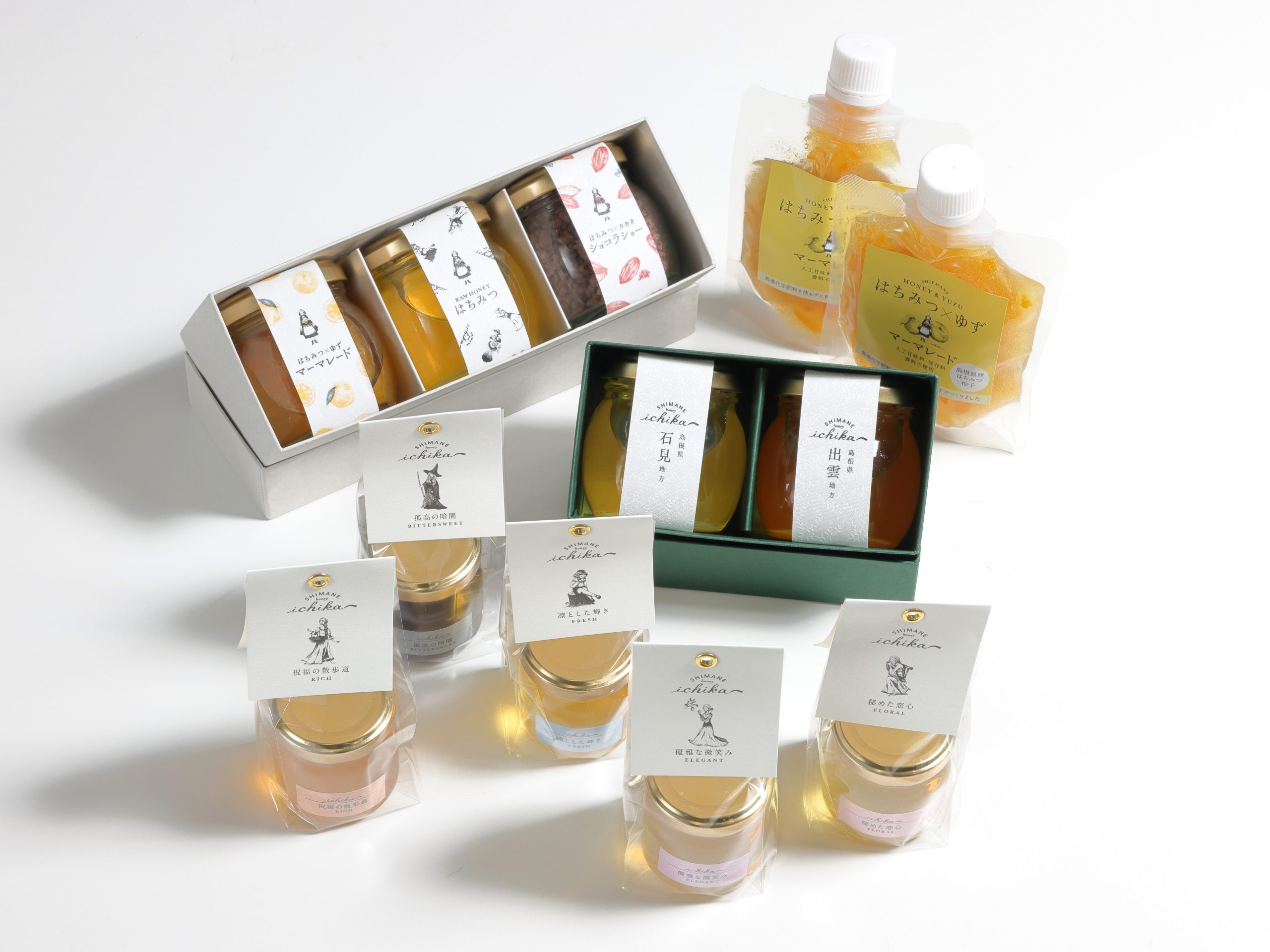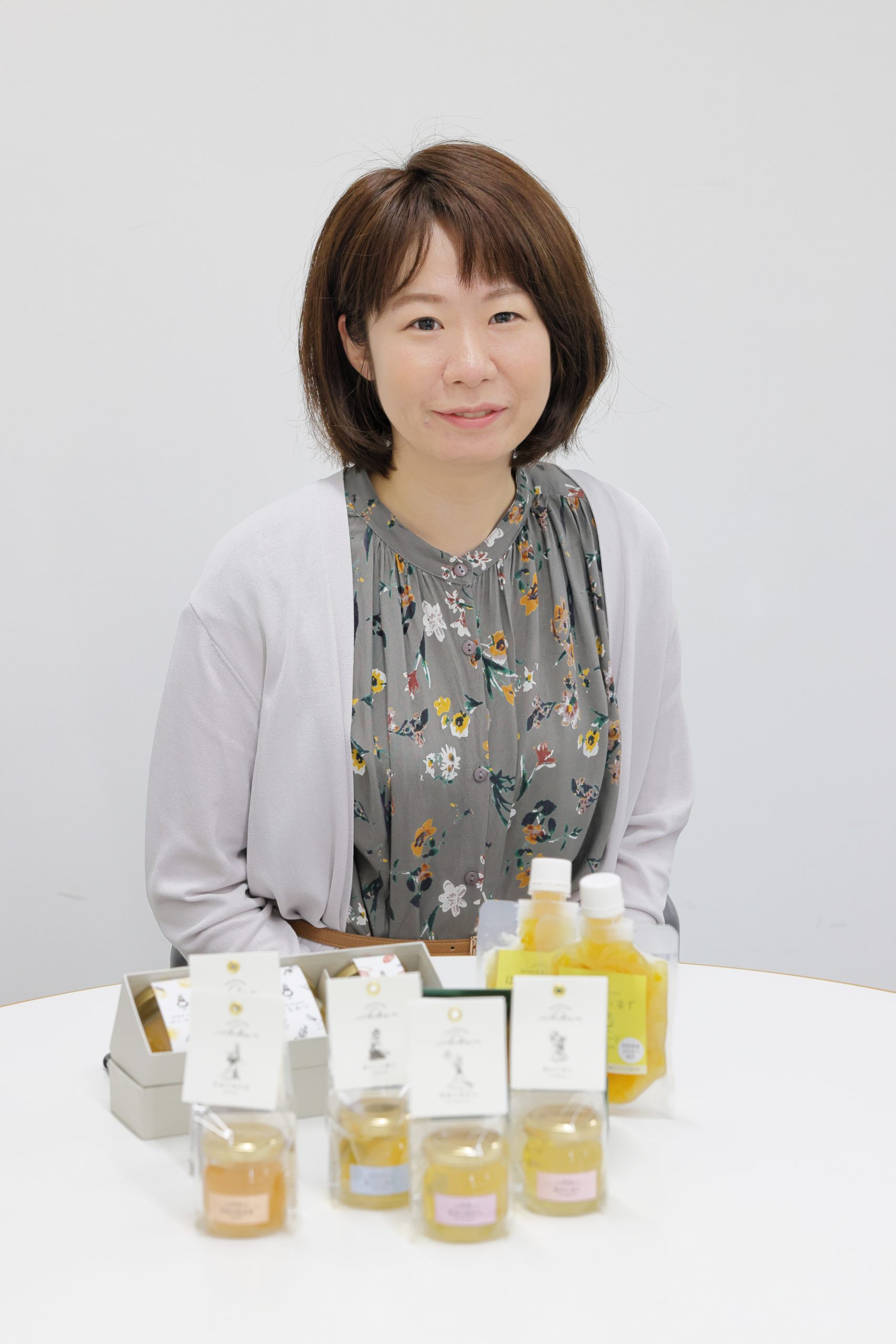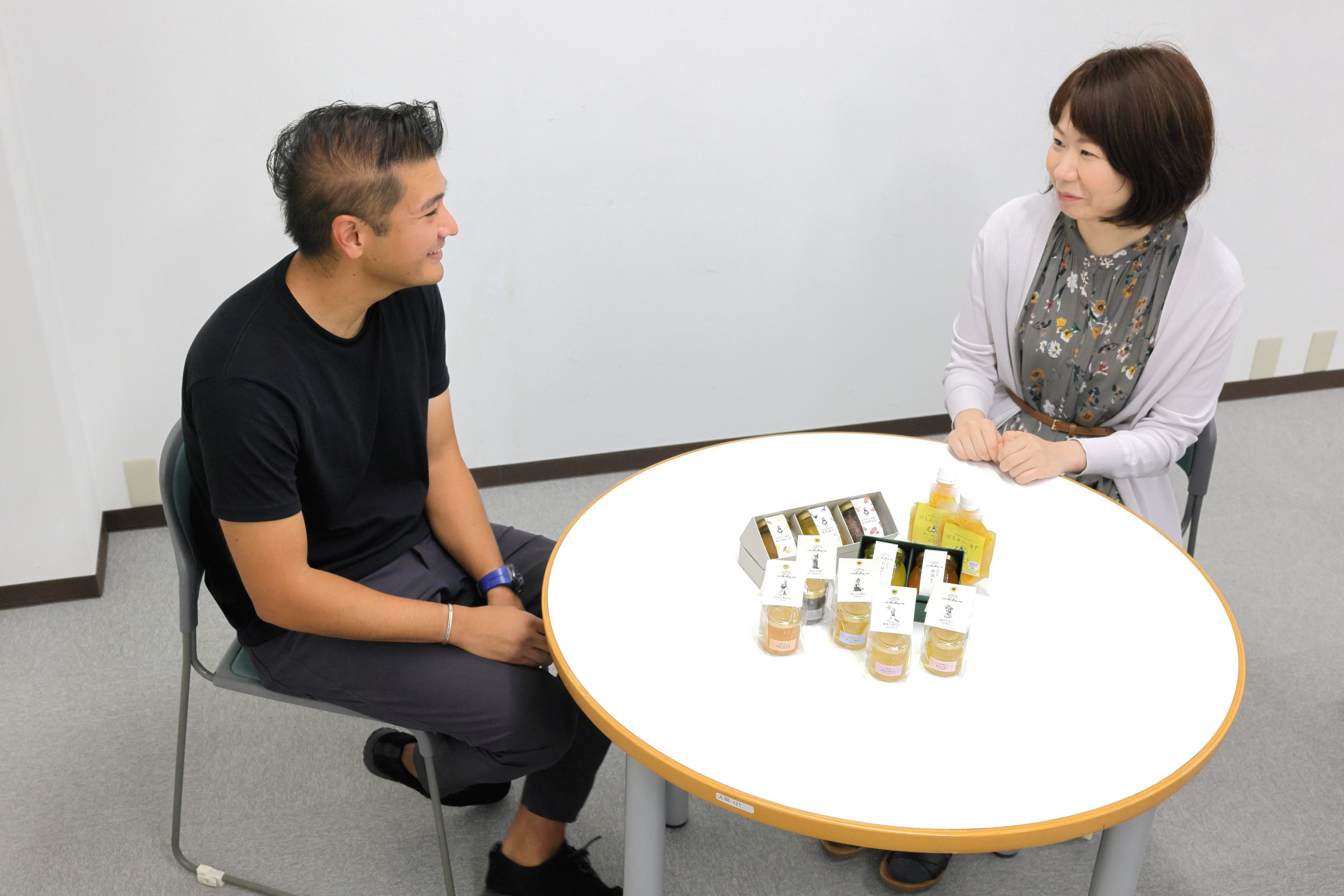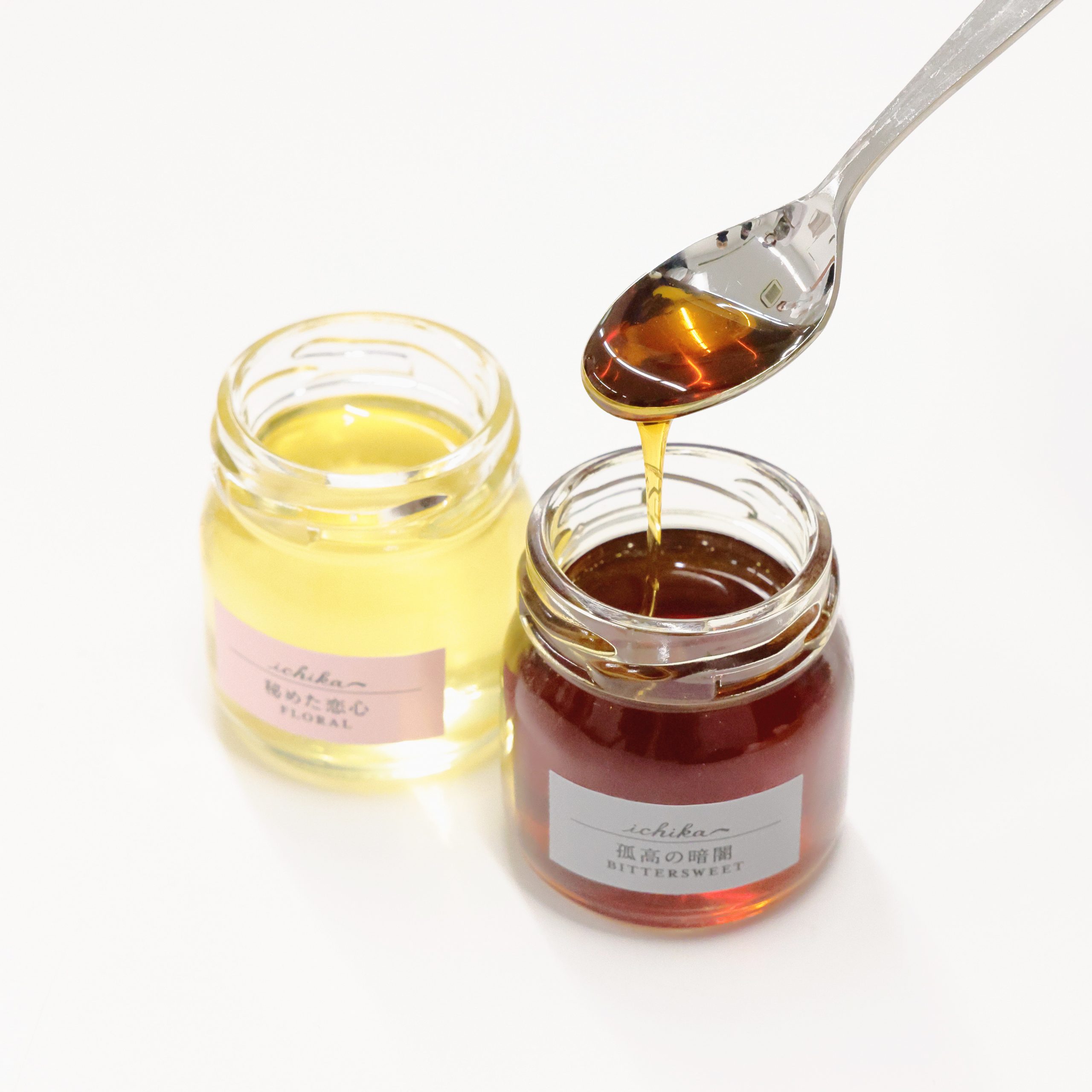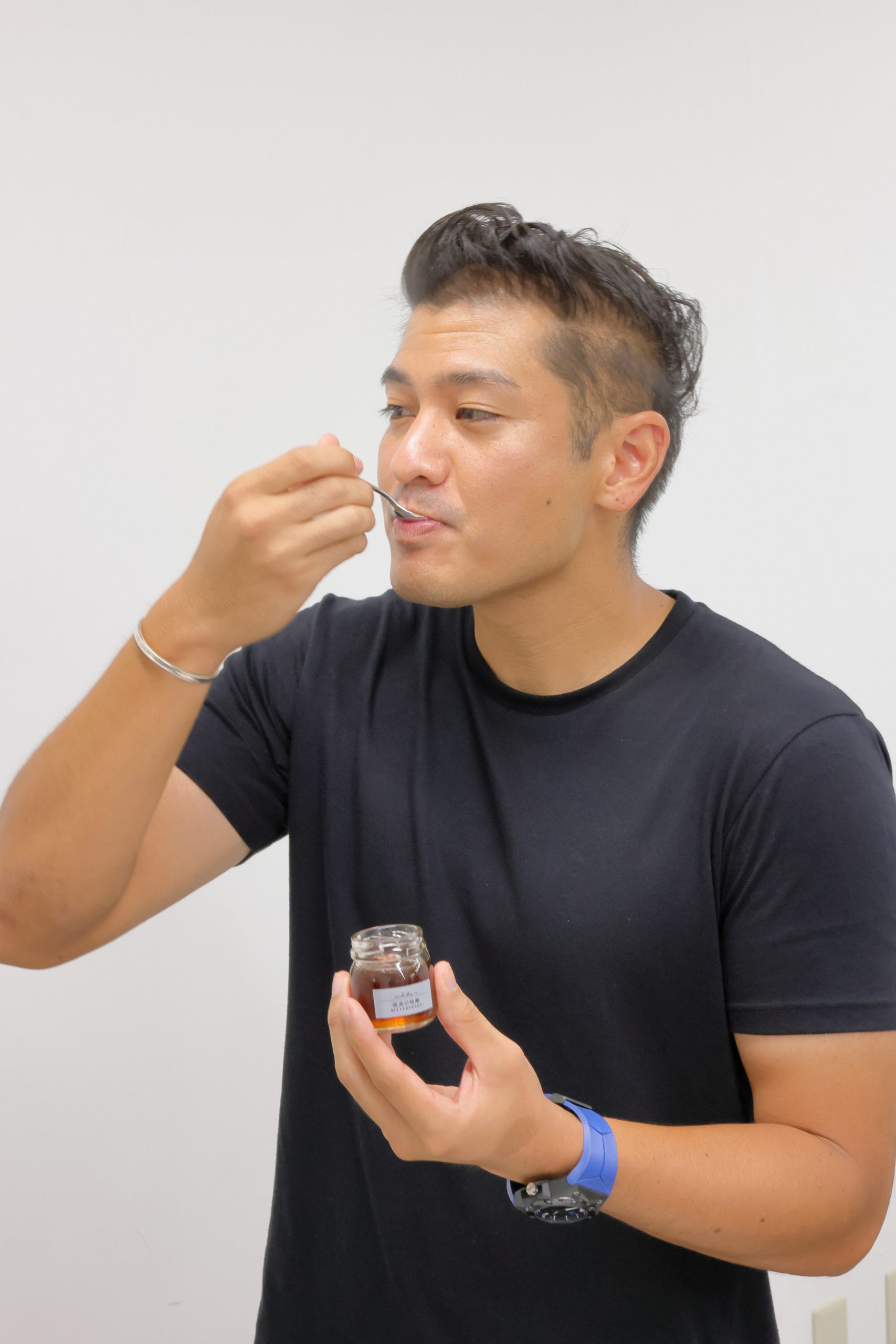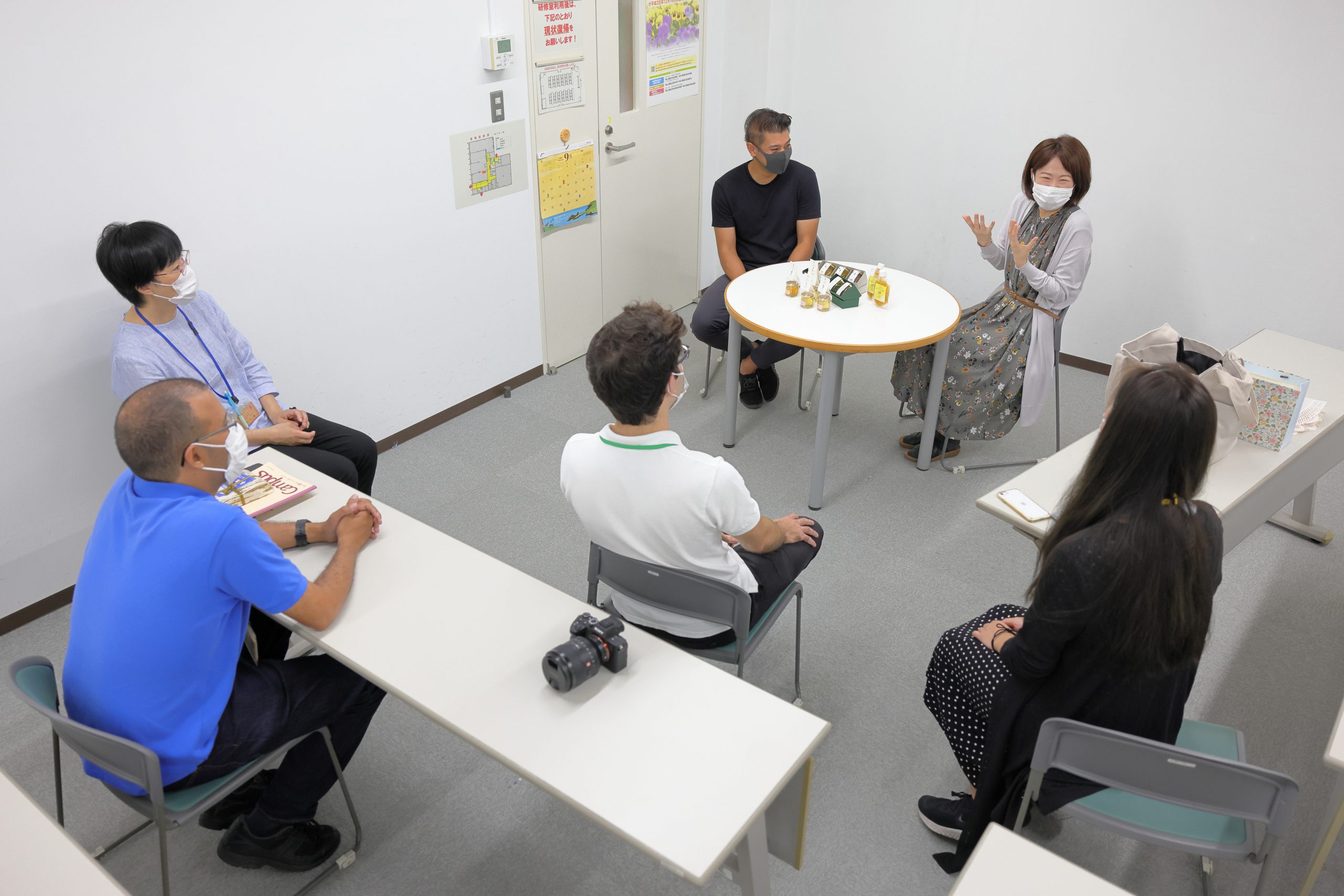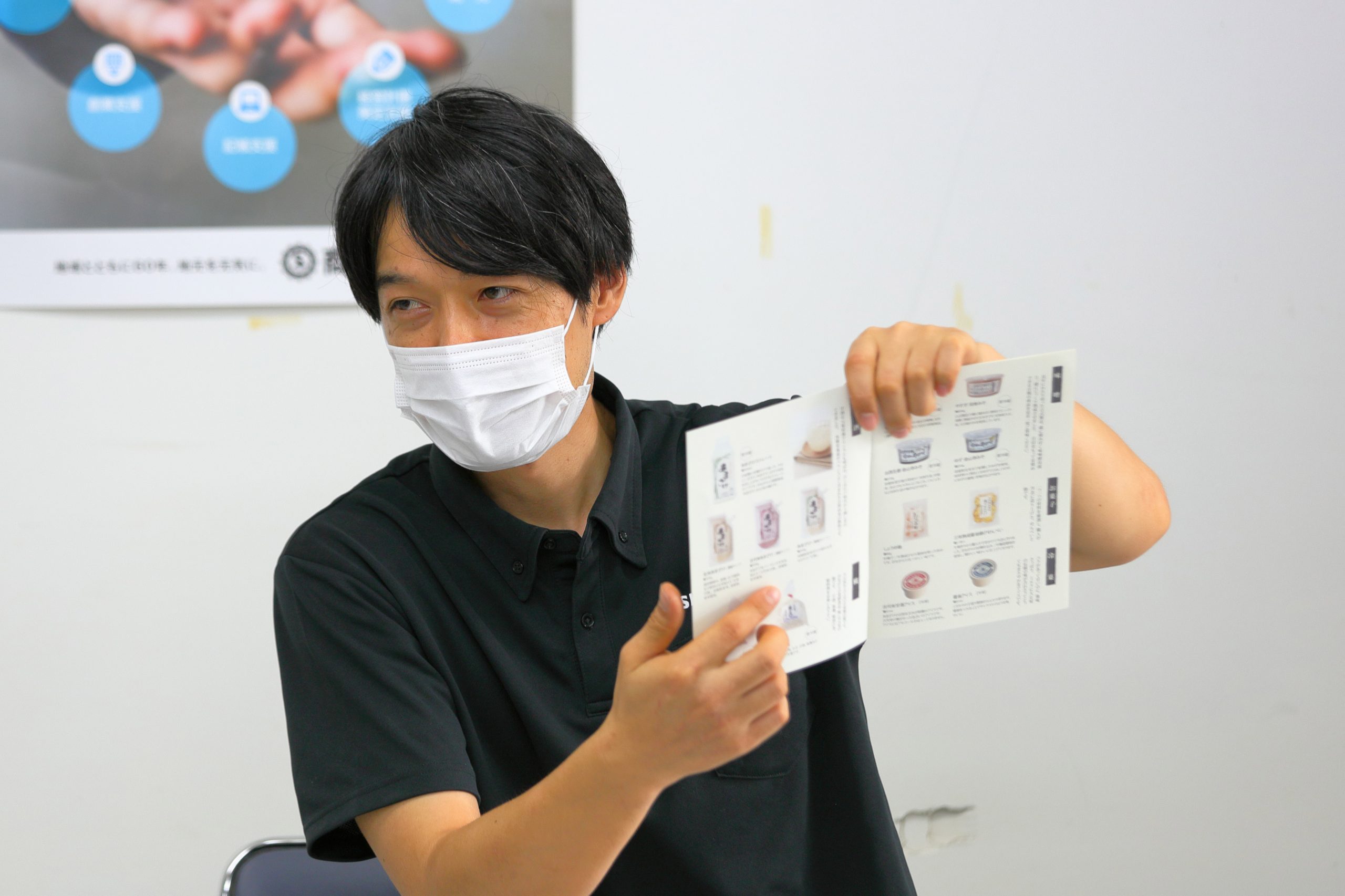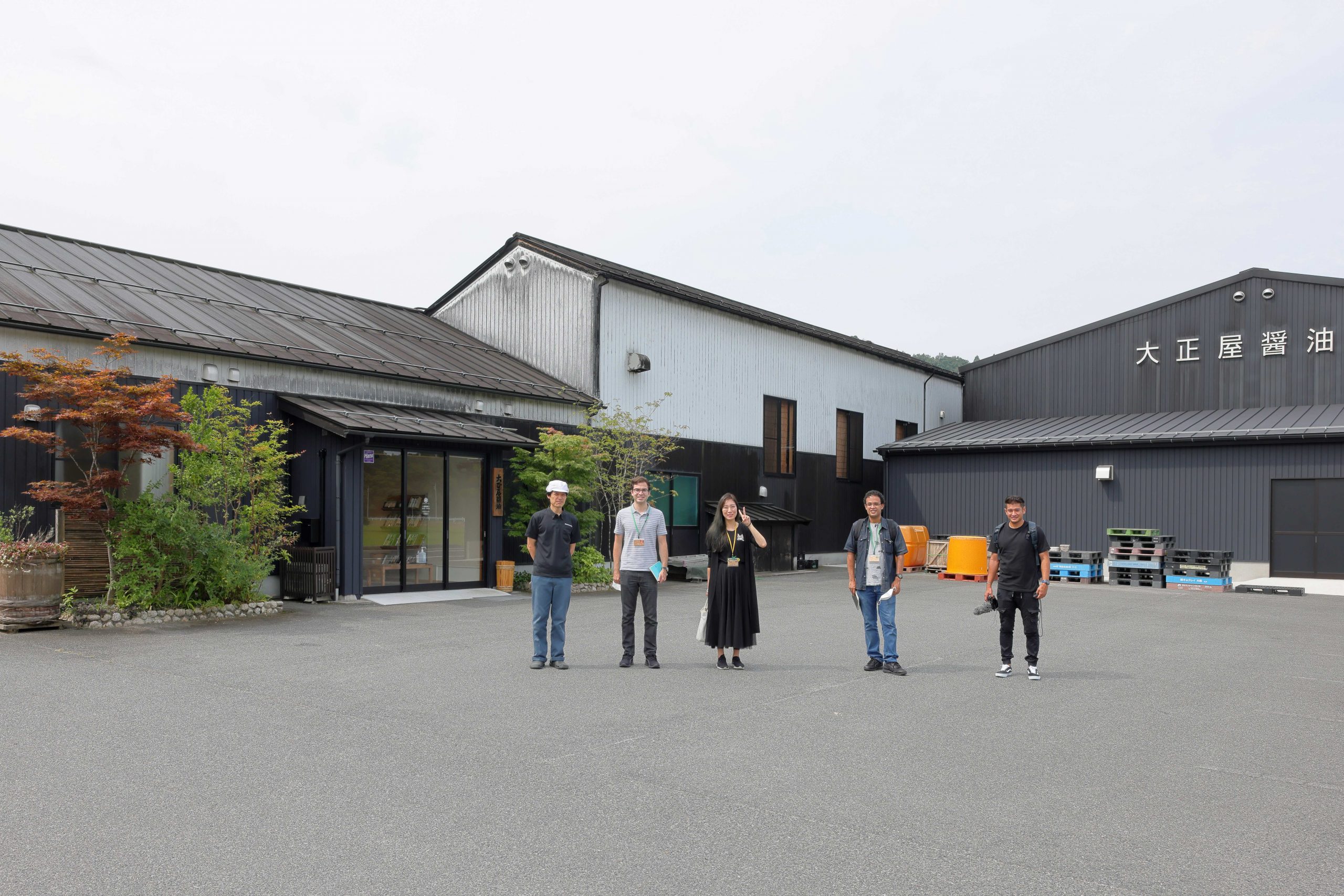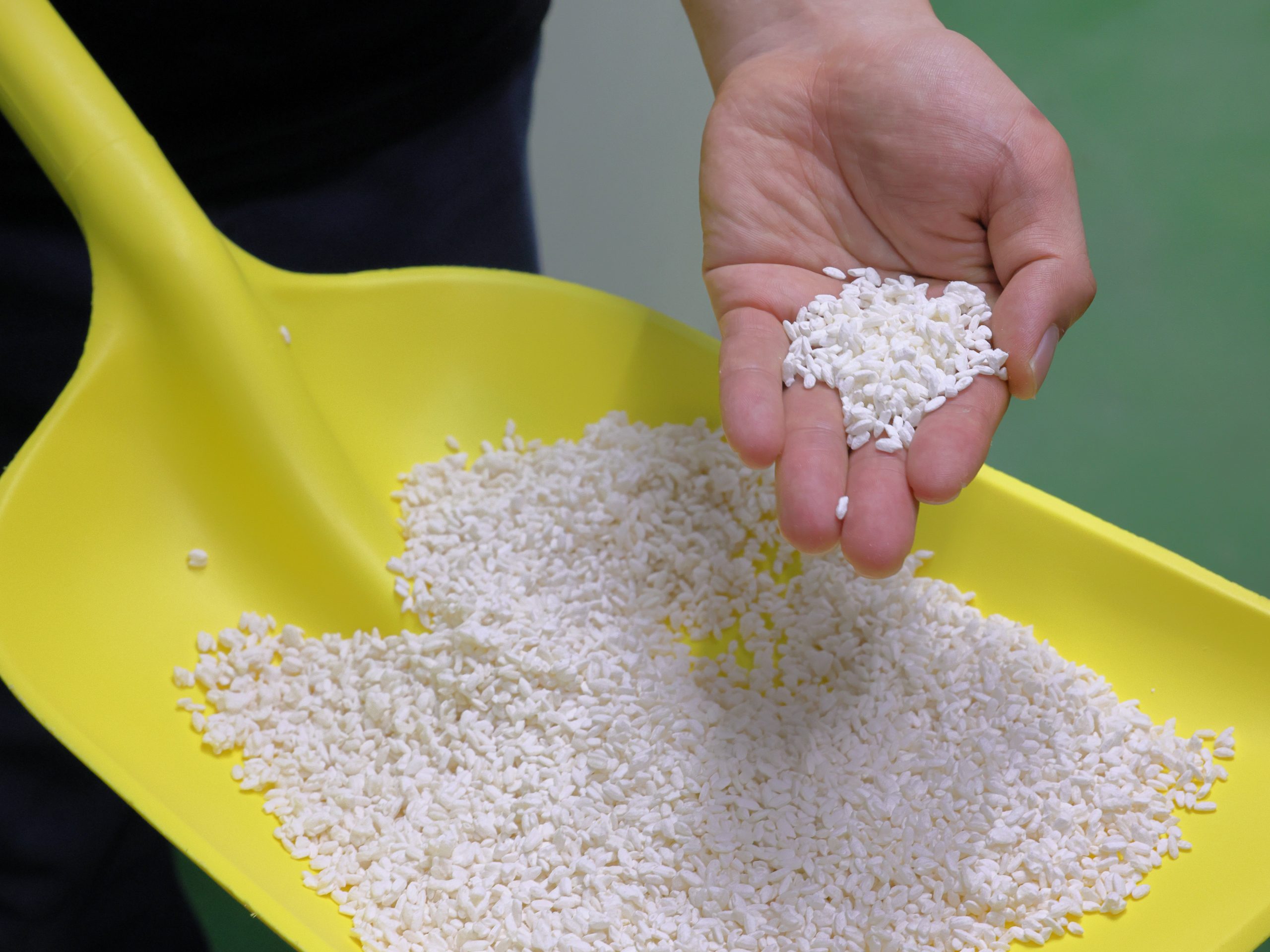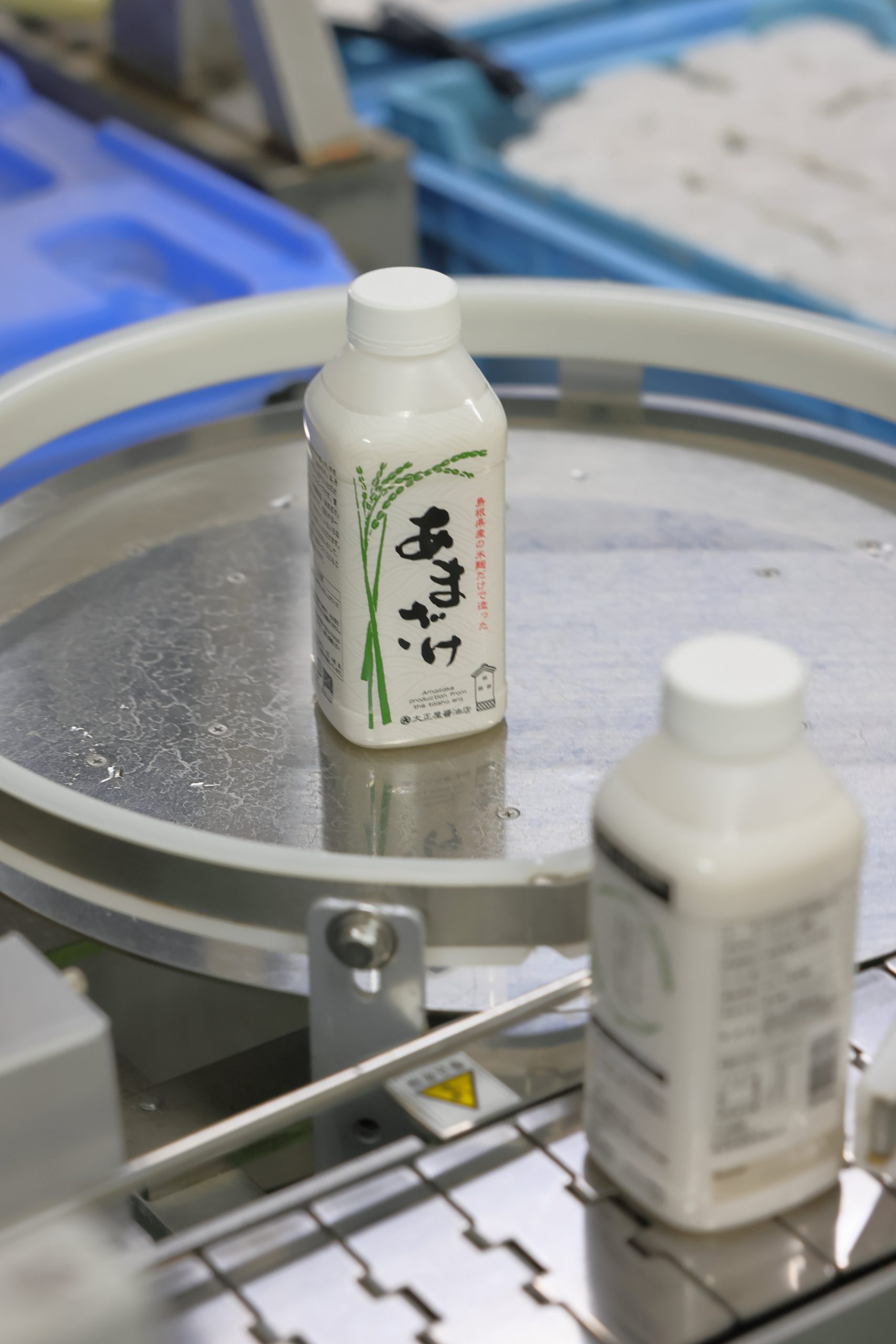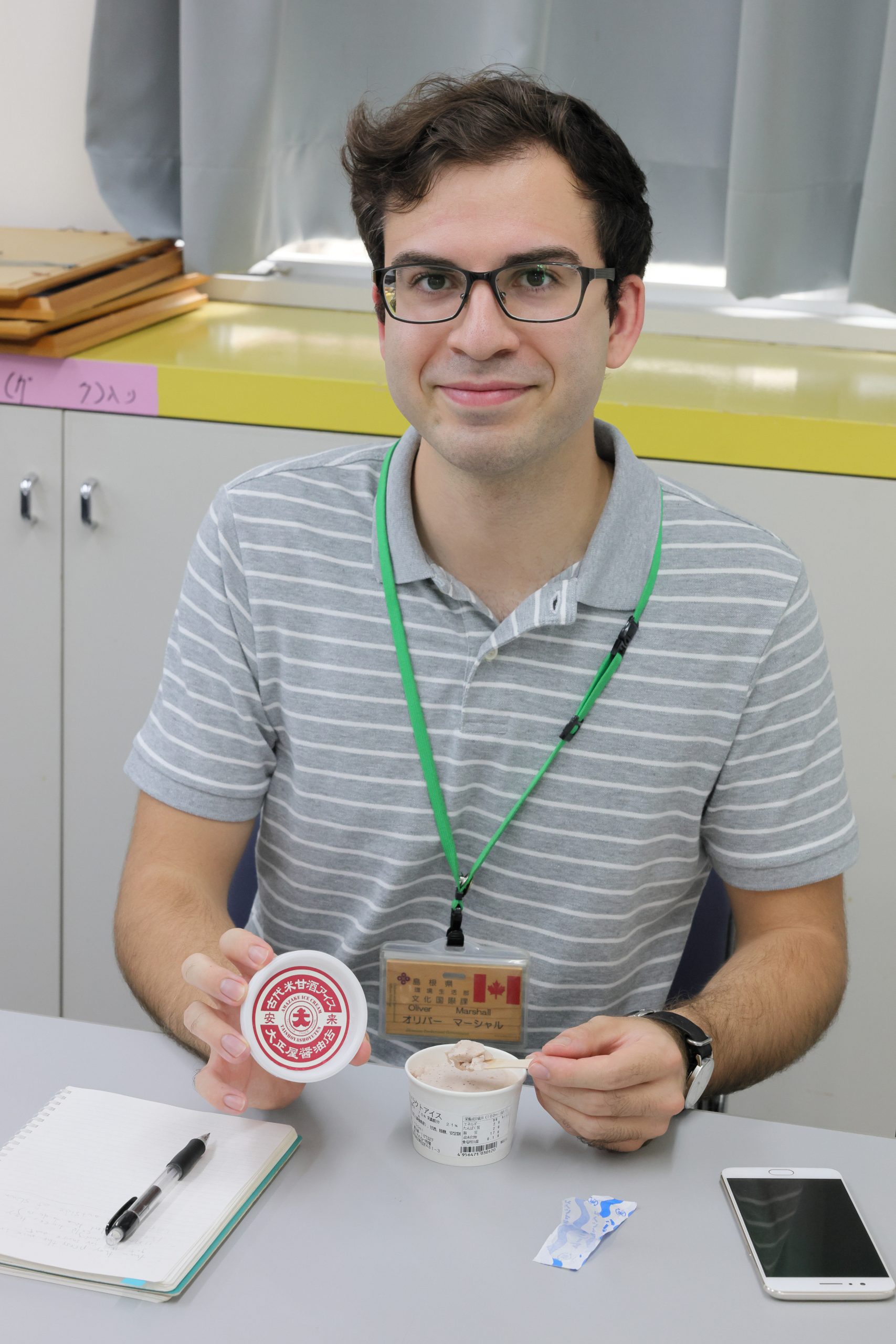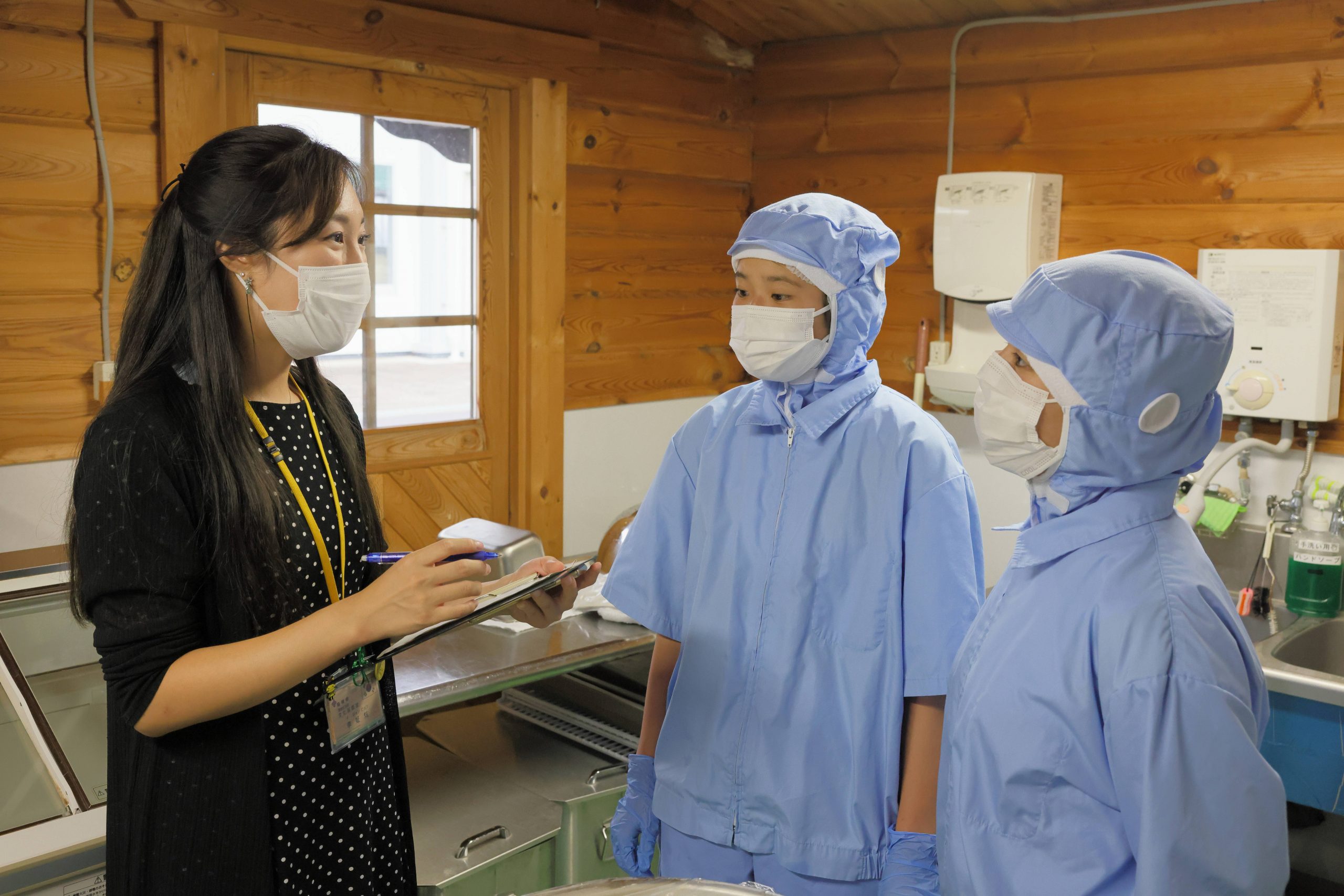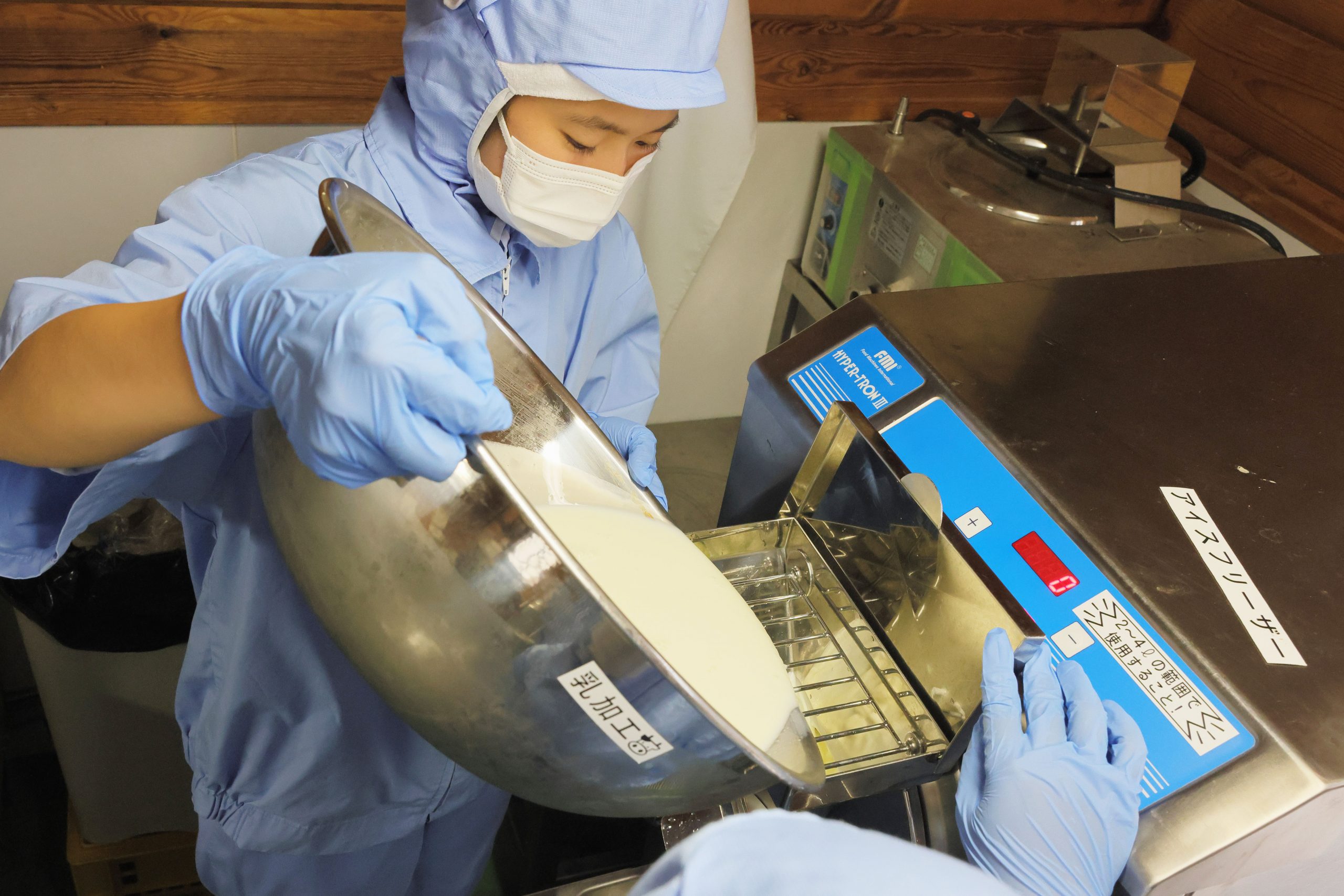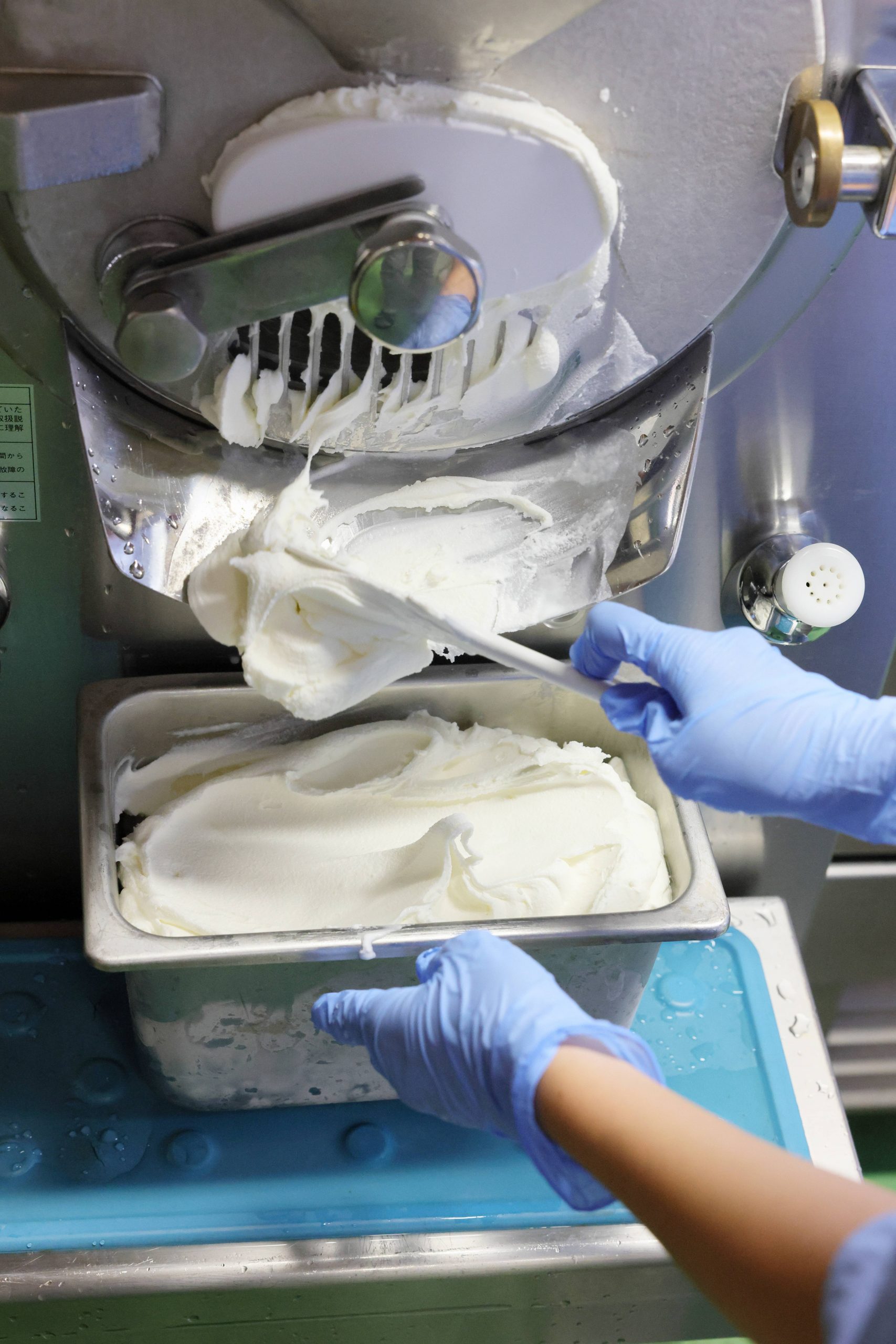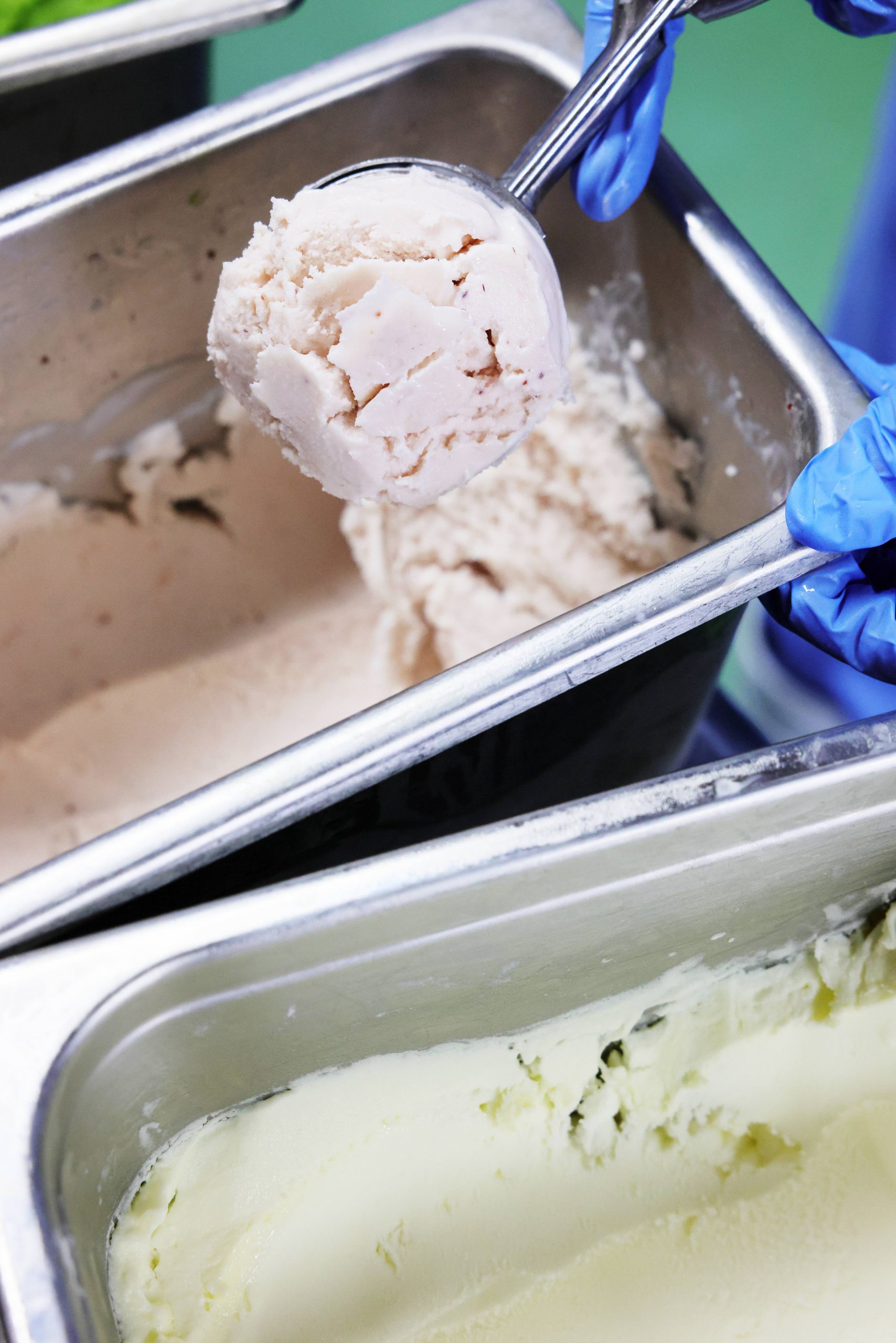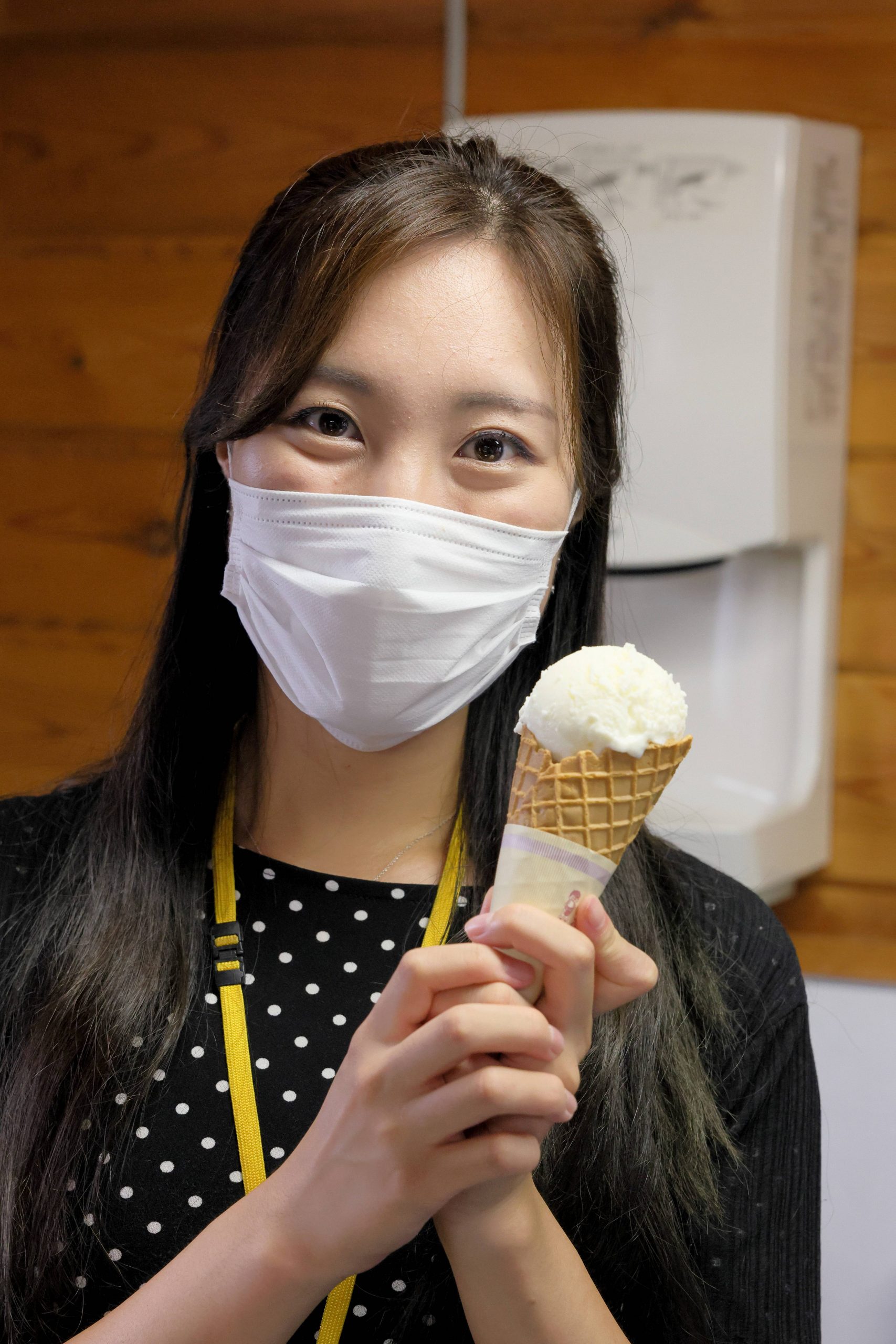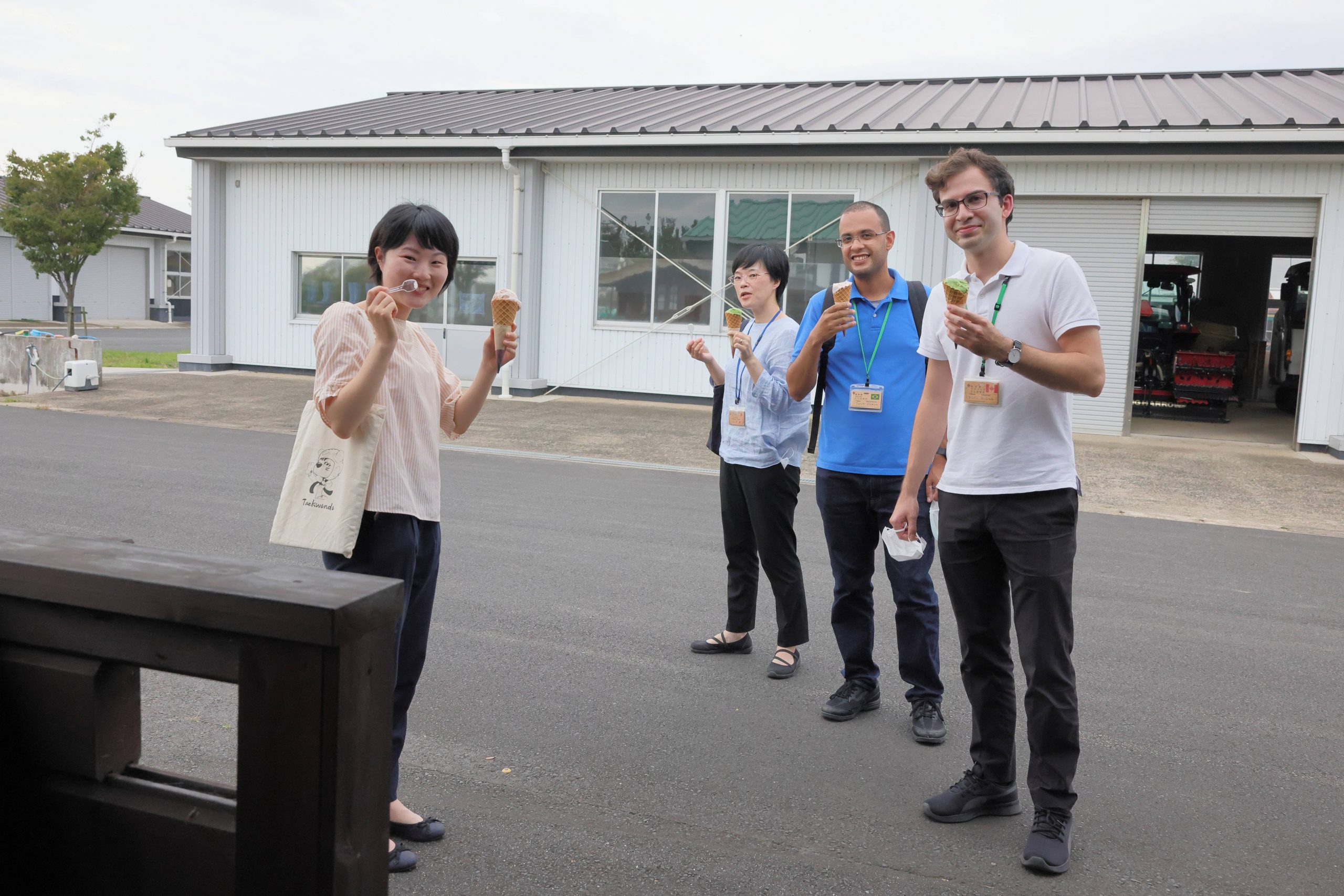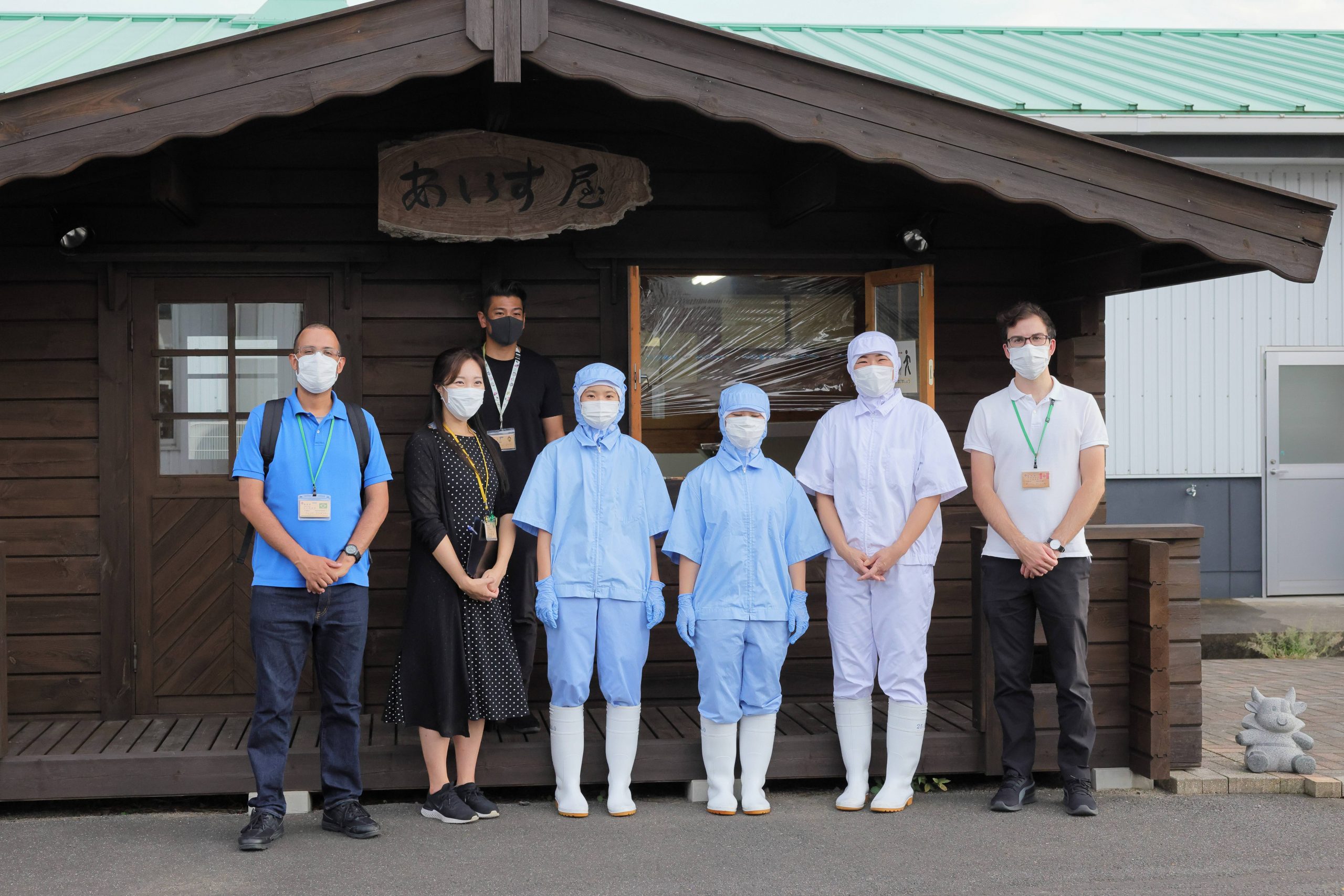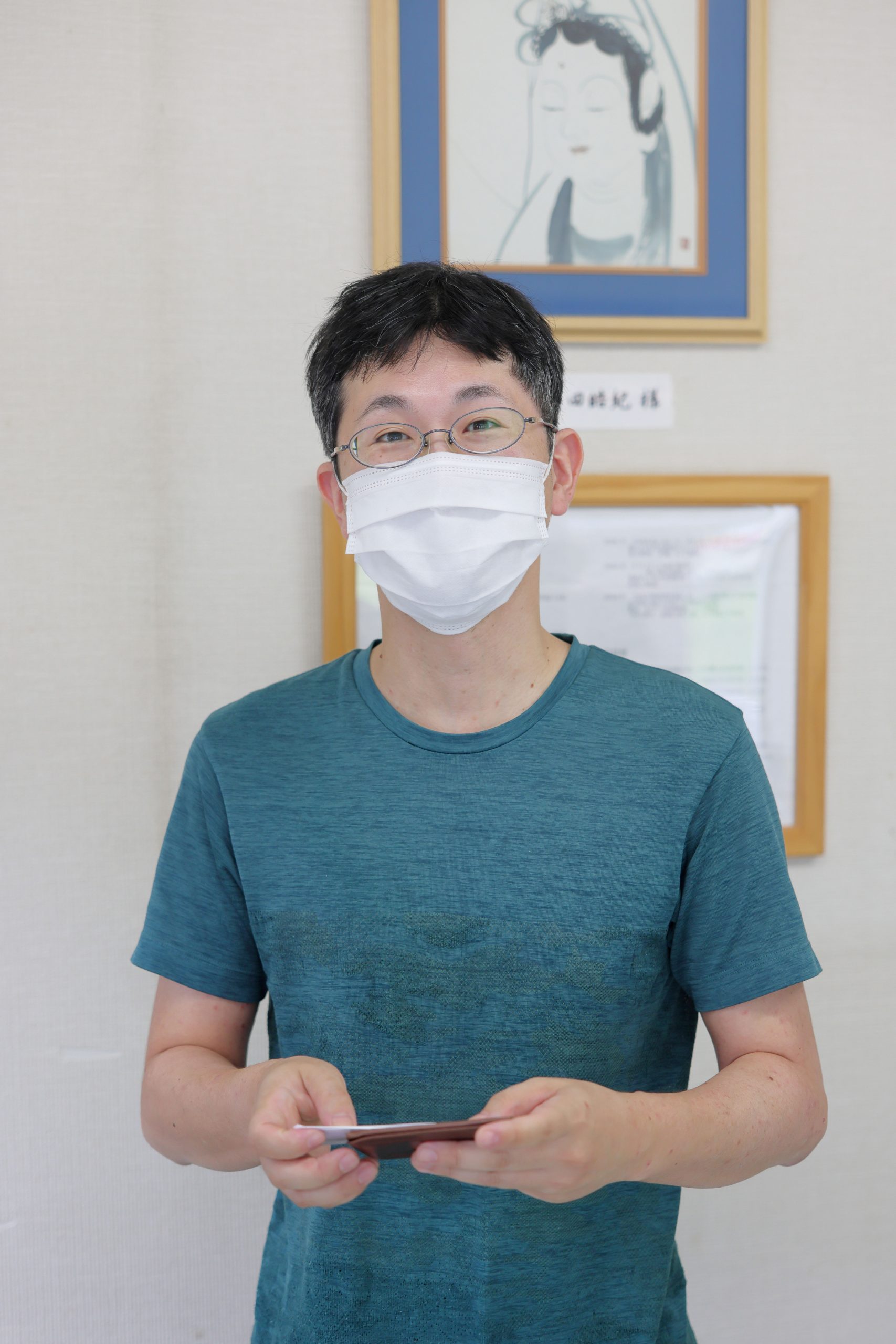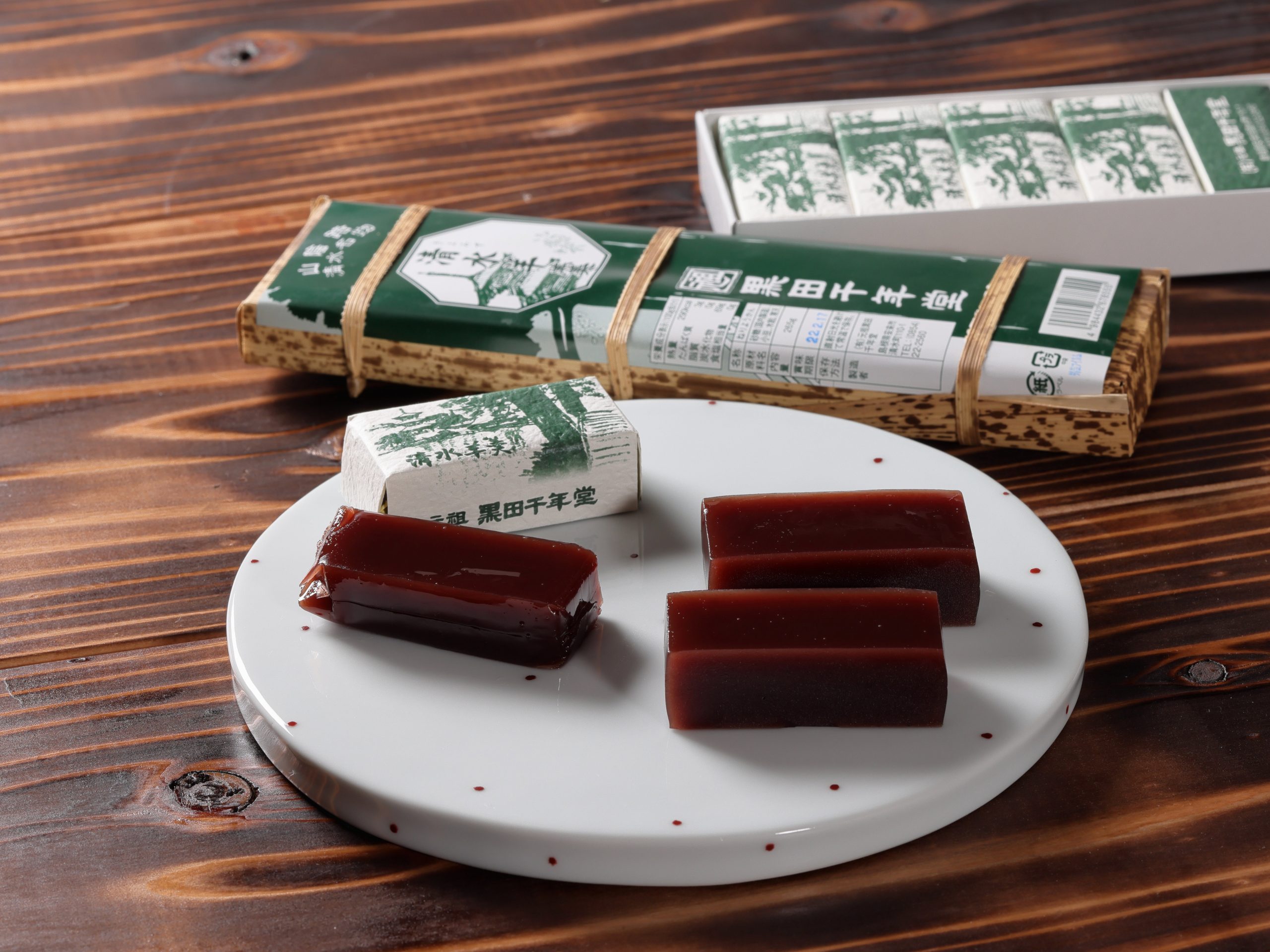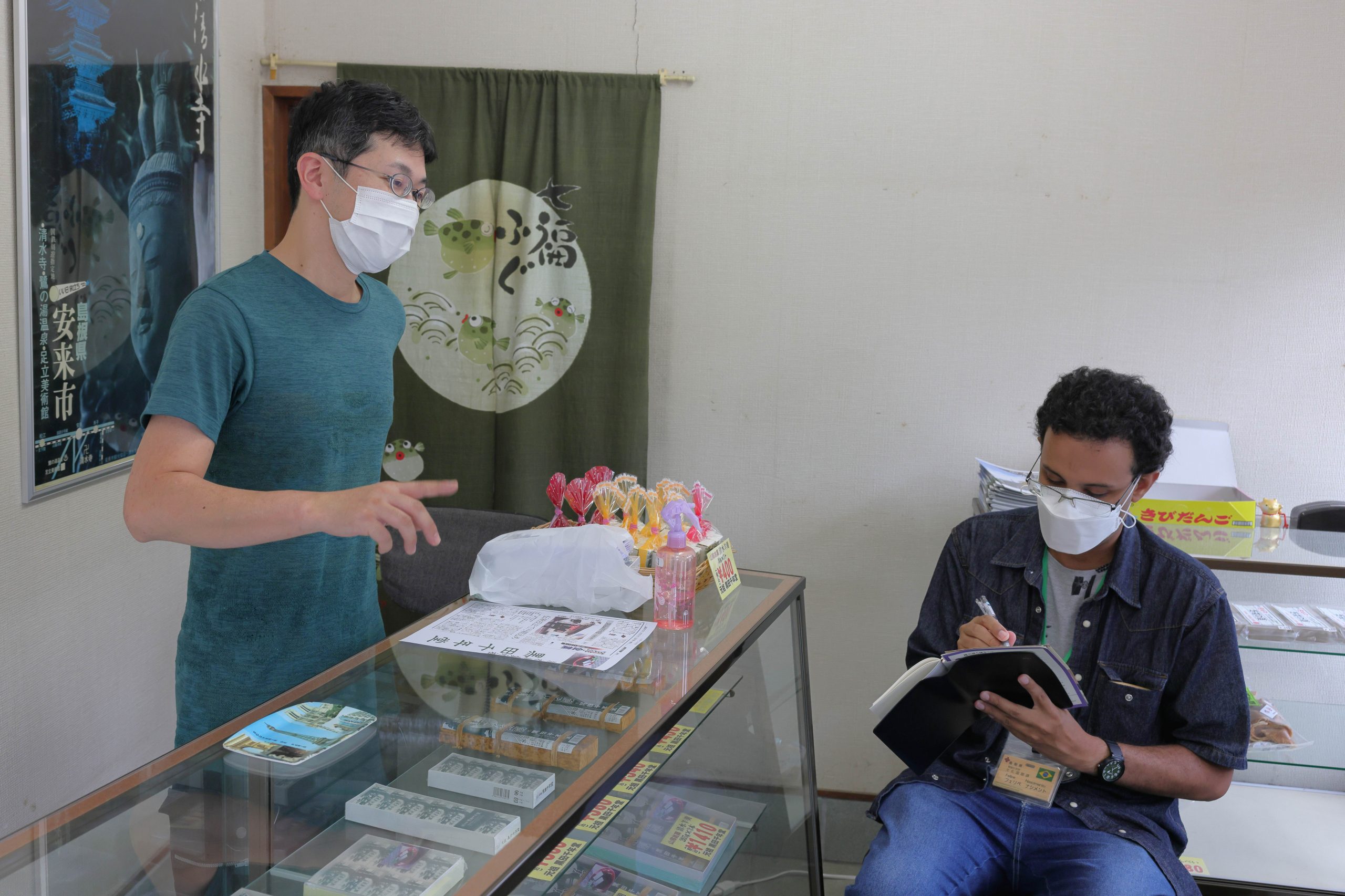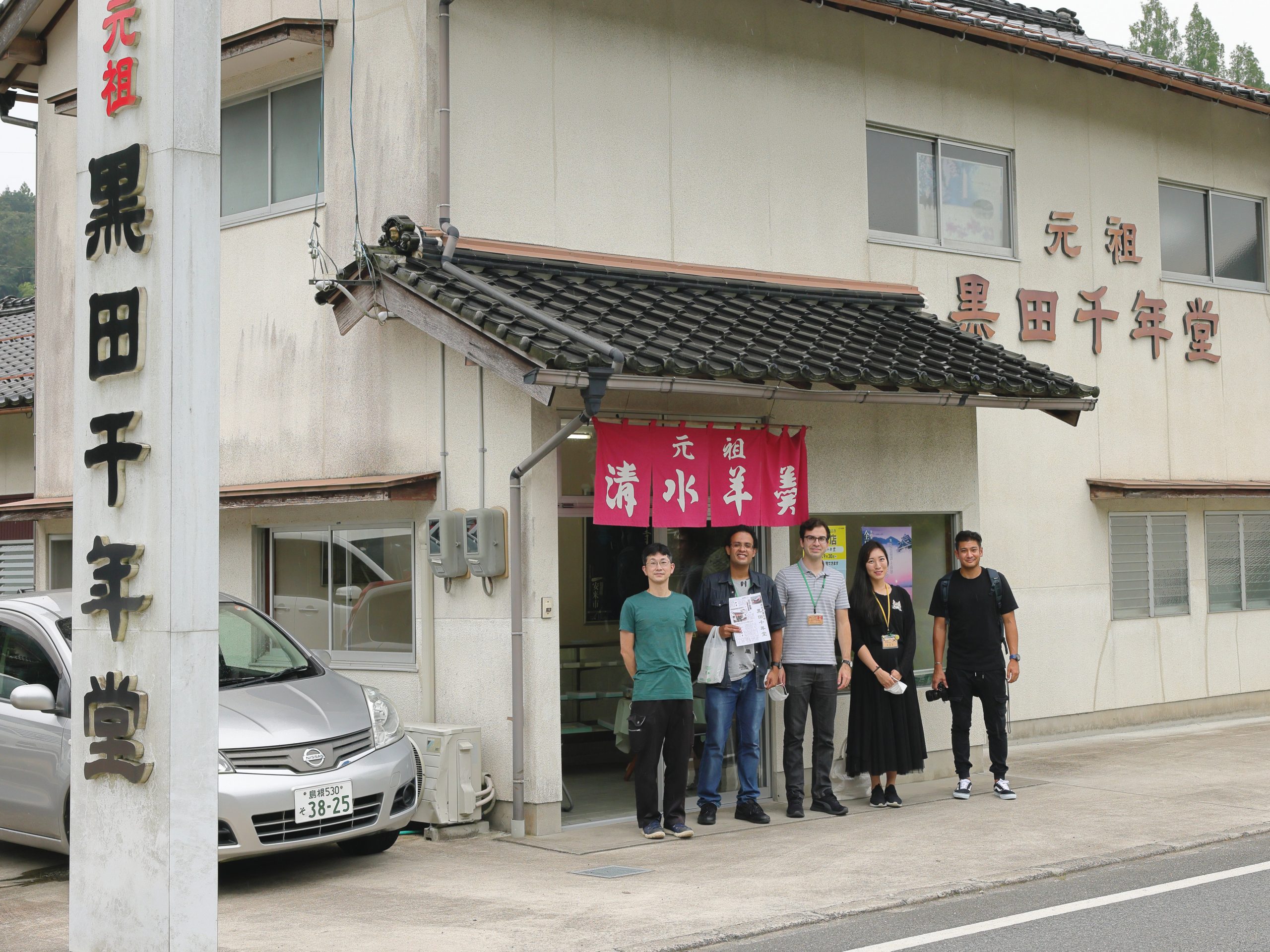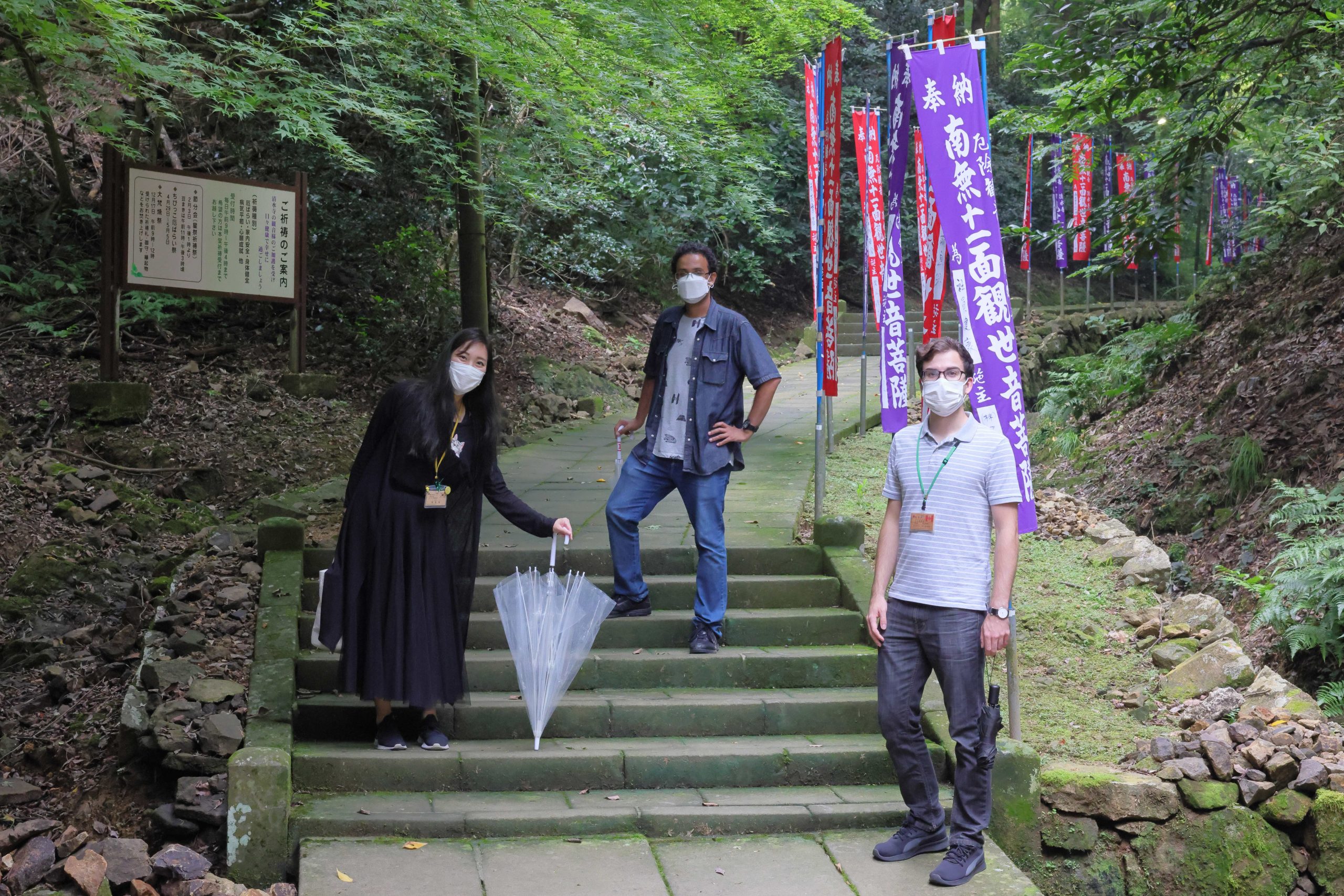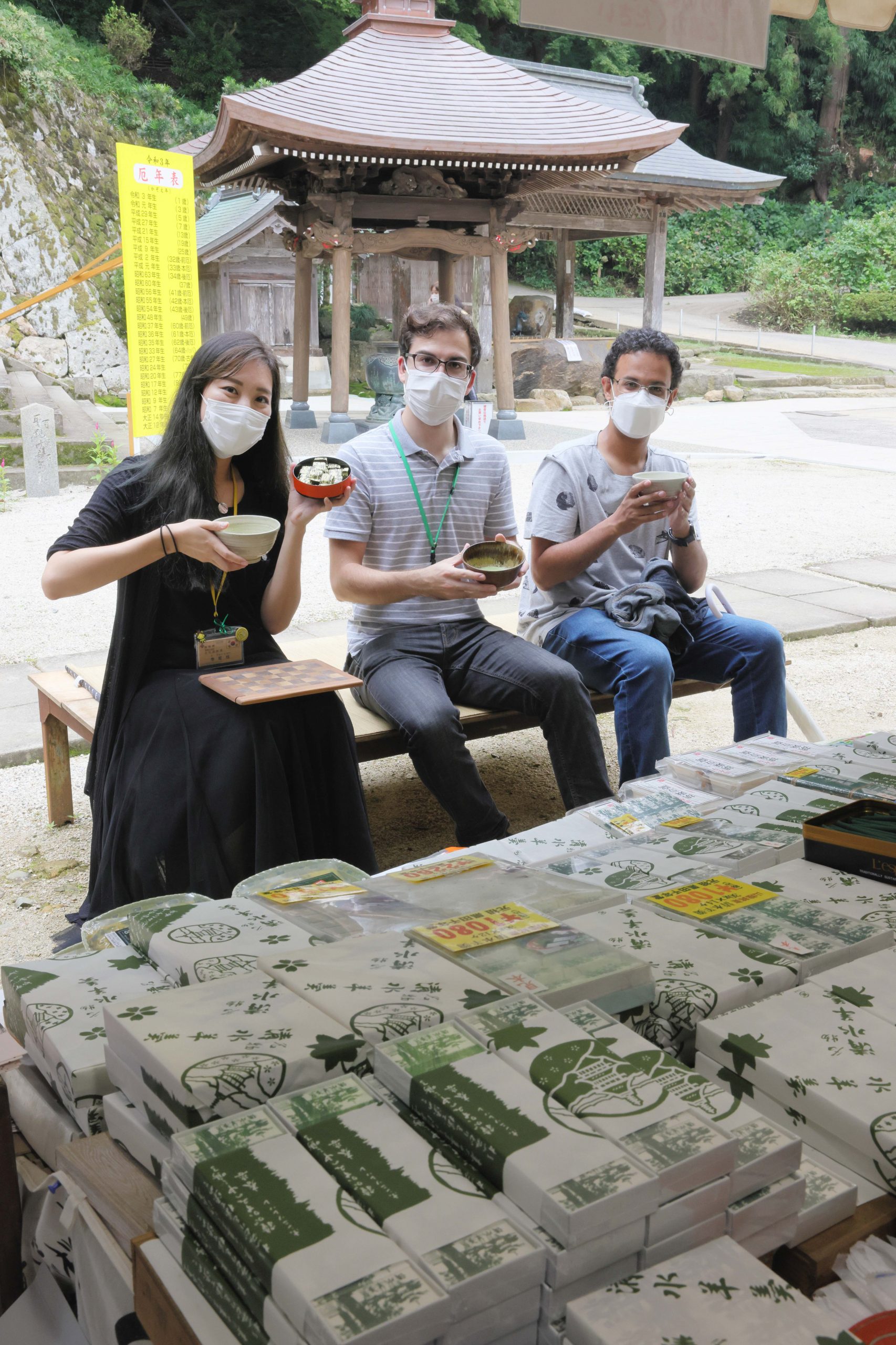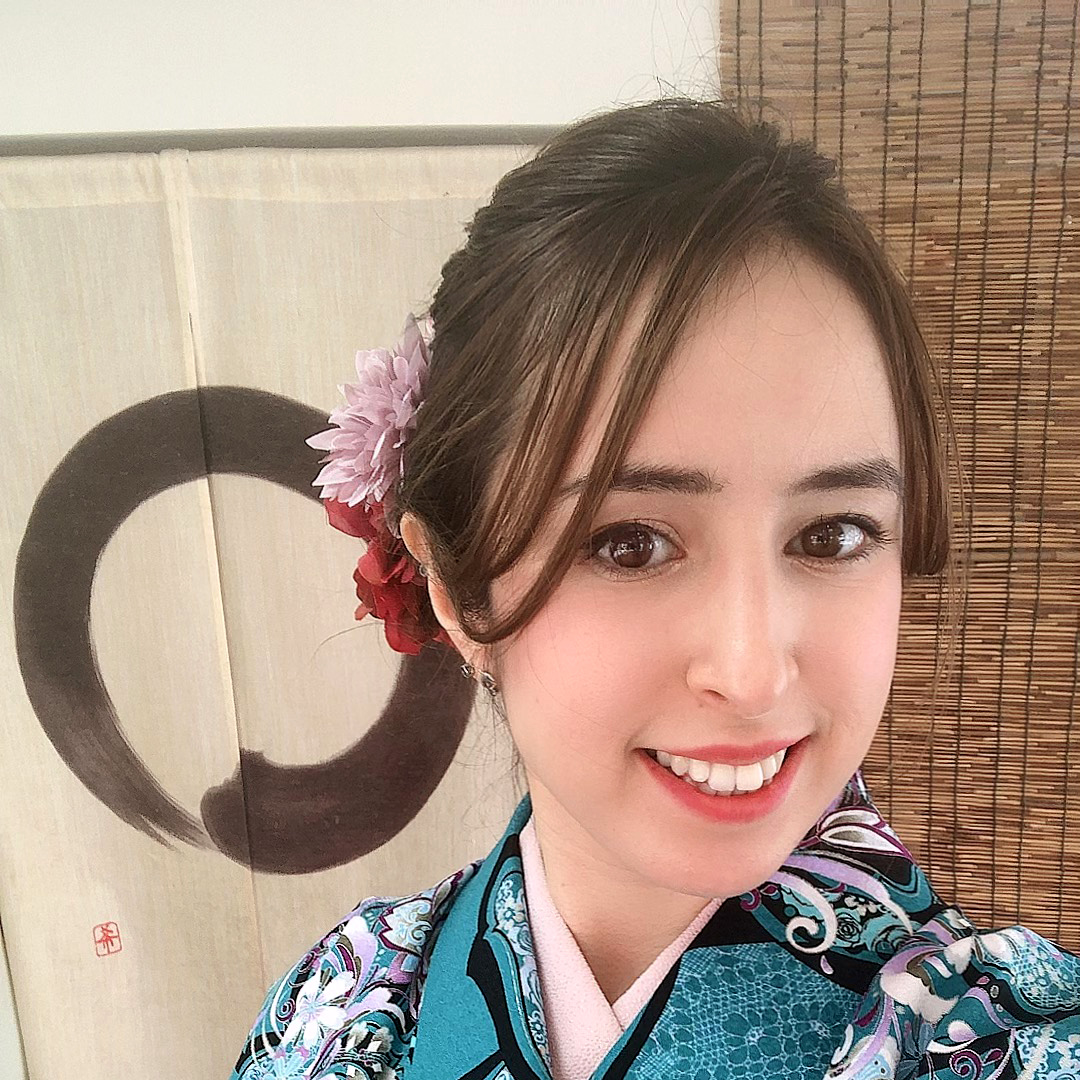Sweet Shimane “The Shimanean Vol.82”
Twice a year, spring/summer and autumn/winter, CIRs (Coordinators for International Relations) visit places throughout Shimane and write about their experiences in their bi-annual magazine Shimanean. The CIRs represent their different countries and through their articles offer their own perspective to unfamiliar cultural experiences.
This time the CIRs learn about some of the locally made sweets and the connections with the locals.
Raw Experience with Raw Honey
Known as liquid gold, honey has been documented in some of the oldest ancient records. In England it is said that the history of honey is the history of humans. Greeks used honey as a sweetener and as offerings to the gods. Just like the Greeks, ancient Egyptians documented their use of honey as a sweetener and as offerings to the gods, but also used it for embalming their dead. In the old alternative Indian medical system, Ayurveda, honey was documented in detail for its medicinal effects.
As for me, my experience with honey goes as far as honey-roasted, honey-glazed, honey-named cereals and the like. Here in Shimane, I’ve tried some honey ice cream once as well as some honey from Hagi-Iwami airport. So my knowledge and experience with honey is if anything close to none. Which is why I’m glad to have Izumi Chika with us for this issue.
While we usually go out of the office to visit places, Izumi-san visited us. She brought with her about 10 types of honey and her newest creation, honey & yuzu marmalade. While we were all oogling the cute bottles of honey, she was catching up with our coworkers. In fact, before starting her own honey business, Izumi-san used to work here in tourism which is where she knew and worked with some of them. In fact, it was her
coworkers that inspired her to start her own honey business.
Izumi-san grew up regularly eating the honey that she received from her strawberry farmer relatives who kept bees for pollinating their strawberry orchards. And it wasn't until her coworkers mentioned that they had never had local Shimane honey, did she realize that domestic honey isn’t even sold at the local supermarkets, and that most locals haven’t even tried the local honey.
So with that, Ichika was born, a combination of both her names plus her passion for honey, giving people a real taste of Shimane. Ichika only produces raw honey, which means it retains all the flavor as well as the vitamins and enzymes that make it healthy for you that are usually lost when it undergoes heat treatment for filtering. Ichika currently has 10 different flavors of honey that are differentiated by where the honey was harvested. The different flavors of the honeys depend on the types of flowers in the area as well as the seasons. She also explains that there is a difference in the type of bees the honey came from. The two types of bees used are the native Japanese honey bee and the western honey bee. The native Japanese honey bees are naturally found in the wild and cannot communicate with each other, meaning each worker bee flies its own path to its own flower, making the honey harvested contain a greater mixture of flowers from the area. On the other hand, the western honey bees are brought over from overseas and can communicate with each other, so their honey is usually a more uniform collection of flowers in the area.
The flavors of her honey range from a light gold colored standard (Matsue), which is like a basic honey that she recommends to anyone who is getting into honey, to a dark brown bittersweet (Izumo) with a peculiar taste that pairs well with wild game meat and coffee. Her honeys are regularly sold separately in cute 50g bottles, but can be purchased in sets of three, or as a set of two in bigger 120g bottles. The smaller 50g bottles are good for comparing flavors and for people who enjoy different flavors of honey regularly. And especially with their clever naming (Japanese naming), I think they can go well with matching the daily mood. She recommends a teaspoon of honey in the morning as a good way to keep your immune system strong, especially with the all the vitamins that are packed into raw honey. What I also appreciate about her packaging is how it has the information on its flavor profile and what is a recommended pairing for it. Its a great plus for a honey novice like me.
She let us try two different honeys; we chose the floral and bittersweet, which are pretty much on opposite ends of the spectrum in terms of flavor. The floral one is made from honey harvested in Misato Town, with a rich sweetness and refreshing aftertaste and pairs well with vanilla ice cream. The bittersweet, on the other hand, is made from honey harvested in Izumo City, and has a peculiar fragrance with a sweetness similar to that of brown sugar. We then tasted both honeys to compare and taste the difference. We tried the floral one first which was a nice flowery sweetness, and then bittersweet, which tasting right after something so sweet had a strong bitter taste with some of my coworkers saying the intensity reminded them of soy sauce. Out of the two I enjoyed the bittersweet one; to me the flavor was deeper with a sweetness that tasted aged with a nice level of bitterness.
Her plans for the future are to one day make honey collected from all 19 cities and towns in Shimane, and to expand her collaborative efforts with local farmers, like her honey & yuzu marmalade. With her honey and products containing the raw taste of Shimane, I hope to see more of her products in the future and look forward to tasting more of Shimane.
(written by: Donovan Goto)
As for me, my experience with honey goes as far as honey-roasted, honey-glazed, honey-named cereals and the like. Here in Shimane, I’ve tried some honey ice cream once as well as some honey from Hagi-Iwami airport. So my knowledge and experience with honey is if anything close to none. Which is why I’m glad to have Izumi Chika with us for this issue.
While we usually go out of the office to visit places, Izumi-san visited us. She brought with her about 10 types of honey and her newest creation, honey & yuzu marmalade. While we were all oogling the cute bottles of honey, she was catching up with our coworkers. In fact, before starting her own honey business, Izumi-san used to work here in tourism which is where she knew and worked with some of them. In fact, it was her
coworkers that inspired her to start her own honey business.
Izumi-san grew up regularly eating the honey that she received from her strawberry farmer relatives who kept bees for pollinating their strawberry orchards. And it wasn't until her coworkers mentioned that they had never had local Shimane honey, did she realize that domestic honey isn’t even sold at the local supermarkets, and that most locals haven’t even tried the local honey.
So with that, Ichika was born, a combination of both her names plus her passion for honey, giving people a real taste of Shimane. Ichika only produces raw honey, which means it retains all the flavor as well as the vitamins and enzymes that make it healthy for you that are usually lost when it undergoes heat treatment for filtering. Ichika currently has 10 different flavors of honey that are differentiated by where the honey was harvested. The different flavors of the honeys depend on the types of flowers in the area as well as the seasons. She also explains that there is a difference in the type of bees the honey came from. The two types of bees used are the native Japanese honey bee and the western honey bee. The native Japanese honey bees are naturally found in the wild and cannot communicate with each other, meaning each worker bee flies its own path to its own flower, making the honey harvested contain a greater mixture of flowers from the area. On the other hand, the western honey bees are brought over from overseas and can communicate with each other, so their honey is usually a more uniform collection of flowers in the area.
The flavors of her honey range from a light gold colored standard (Matsue), which is like a basic honey that she recommends to anyone who is getting into honey, to a dark brown bittersweet (Izumo) with a peculiar taste that pairs well with wild game meat and coffee. Her honeys are regularly sold separately in cute 50g bottles, but can be purchased in sets of three, or as a set of two in bigger 120g bottles. The smaller 50g bottles are good for comparing flavors and for people who enjoy different flavors of honey regularly. And especially with their clever naming (Japanese naming), I think they can go well with matching the daily mood. She recommends a teaspoon of honey in the morning as a good way to keep your immune system strong, especially with the all the vitamins that are packed into raw honey. What I also appreciate about her packaging is how it has the information on its flavor profile and what is a recommended pairing for it. Its a great plus for a honey novice like me.
She let us try two different honeys; we chose the floral and bittersweet, which are pretty much on opposite ends of the spectrum in terms of flavor. The floral one is made from honey harvested in Misato Town, with a rich sweetness and refreshing aftertaste and pairs well with vanilla ice cream. The bittersweet, on the other hand, is made from honey harvested in Izumo City, and has a peculiar fragrance with a sweetness similar to that of brown sugar. We then tasted both honeys to compare and taste the difference. We tried the floral one first which was a nice flowery sweetness, and then bittersweet, which tasting right after something so sweet had a strong bitter taste with some of my coworkers saying the intensity reminded them of soy sauce. Out of the two I enjoyed the bittersweet one; to me the flavor was deeper with a sweetness that tasted aged with a nice level of bitterness.
Her plans for the future are to one day make honey collected from all 19 cities and towns in Shimane, and to expand her collaborative efforts with local farmers, like her honey & yuzu marmalade. With her honey and products containing the raw taste of Shimane, I hope to see more of her products in the future and look forward to tasting more of Shimane.
(written by: Donovan Goto)
A Healthy Habit! Why Not Try Some Amazake!
In November, the mountains of Shimane turn brilliant shades of red, offering spectacular views wherever you look. As the temperature dips, the humid heat of summer gives way to the refreshing air of autumn.
Speaking of autumn, I’m sure that many people look forward to sweet treats on a cool autumn day. In my home country of Canada, we often enjoy warm desserts such as pie during this time of the year. I have fond memories of weekend afternoons spent strolling through the park with friends, taking in the autumn scenery; afterwards, we would often head to a nearby café and order a hot coffee and slice of fresh pumpkin pie.
This autumn, with the memories of pumpkin pie still fresh in my mind, my colleagues and I embarked on a “sweet” Shimane adventure!
For this issue of The Shimanean, I visited Taishoya Soy Sauce Co. Ltd., located in Yasugi City in eastern Shimane. For close to 100 years, Taishoya Soy Sauce has used local ingredients and traditional methods to produce a variety of soy sauce and miso.
“A ‘sweet’ adventure... at a soy sauce maker?” you may be wondering. In fact, in addition to soy sauce and miso, Taishoya Soy Sauce produces a food that has been attracting renewed attention as part of a health boom in Japan. That food is “amazake,” a product of Shimane’s tradition and nature that has been popular since the Edo period. I had never drunk amazake before coming to Japan, and even after living in Shimane for almost five years, I’ve only tried the traditional drink a handful of times. Even then, my only image of amazake was that of a sweet, slightly alcoholic beverage, as I had only ever drunk amazake made from “sake kasu” (a by-product of sake fermentation). When I heard that Taishoya Soy Sauce instead produces a healthy, non-alcoholic “amazake,” I was eager to learn more.
Starting our “sweet adventure,” I talked to the 4th-generation managing director of Taishoya Soy Sauce, Mr. Yamamoto Shusaku. According to Mr. Yamamoto, there are two basic kinds of amazake. The first is amazake made from “sake kasu,” which is the only type that I had previously tried. Historically in the San’in region (comprising Shimane and Tottori Prefectures), when people spoke about “amazake,” they were usually referring to this particular type. However, there is another type of amazake consisting of rice “koji” (fermented rice) and water, which was historically known as “amagayu” (literally “sweet rice congee”). This latter type has become popular in recent years for its health benefits. “Nowadays, when people in Shimane speak about ‘amazake,’ they are most likely referring to the non-alcoholic, simple rice drink,” said Mr. Yamamoto. The amazake produced at Taishoya Soy Sauce also happens to be this latter type.
Next, Mr. Yamamoto explained the production process. Taishoya Soy Sauce uses local rice grown in Yasugi City. While sake brewers often use special strains of rice, Taishoya Soy Sauce uses common types of rice from Shimane that are eaten on a daily basis.
As with soy sauce, miso, and sake, the production of amazake starts with rice koji. Koji is made by first steaming rice, and then adding a small amount of mold (a.k.a. “starter culture”) to the steamed rice. Over three days, the mold spreads throughout the rice. To help cultivate the mold, the production room must be kept at a precise temperature and humidity.
The rest of the process is fairly simple; after three days, rice and water are added to the koji. The mixture is left overnight in a warm tank, which causes the enzymes in the rice to break down, forming amazake. In the morning, staff then bottle the amazake. In only four days, a naturally sweet amazake is produced without using any added sugar.
“How does the amazake become sweet, without adding any sugar?” I wondered. As if on cue, Mr. Yamamoto then explained the sweetening process. “In fact, if you chew rice in your mouth for a long period of time, you’ll notice that the rice becomes sweeter. This is the same process. The enzymes in the koji break down the starch in the rice, which makes the amazake sweet. No sugar is addedd-rather, the starch is naturally turned into glucose. And because this process only takes four days, it’s much faster to make amazake than soy sauce or sake!”
Amazake is rich in amino acids and vitamins, which is why it is also known as “drinkable intravenous drip” in Japan. As amazake has become recognized as a health drink, people who wish to avoid added sugars can enjoy the natural sweetness of amazake, either as a drink or as a sweetener.
In addition to straight amazake which can be enjoyed on its own, Taishoya Soy Sauce produces offers three other concentrated types: white rice amazake, “ancient rice” amazake made from purple rice, and a “genmai” type made from brown rice. These concentrated types can be used as a topping for yogurt, or as an ingredient in sweets. According to Mr. Yamamoto, most people used to drink white rice amazake, but with the increase of health-conscious consumers, drinking amazake has become a healthy habit-nowadays, brown rice amazake is the best seller.
Before leaving Taishoya Soy Sauce, I bought some “ancient rice” amazake to try. For breakfast, I often eat hot oatmeal sweetened with maple syrup, and when I tried the amazake as a substitute sweetener, it was delicious! The distinctive taste of the purple rice was perfectly balanced with a gentle sweetness, and I really felt like I could include amazake as a pantry staple. I will definitely recommend amazake̶-a gift of nature from Shimane̶-to my friends and family in Canada.
(written by: Oliver Marshall)
Speaking of autumn, I’m sure that many people look forward to sweet treats on a cool autumn day. In my home country of Canada, we often enjoy warm desserts such as pie during this time of the year. I have fond memories of weekend afternoons spent strolling through the park with friends, taking in the autumn scenery; afterwards, we would often head to a nearby café and order a hot coffee and slice of fresh pumpkin pie.
This autumn, with the memories of pumpkin pie still fresh in my mind, my colleagues and I embarked on a “sweet” Shimane adventure!
For this issue of The Shimanean, I visited Taishoya Soy Sauce Co. Ltd., located in Yasugi City in eastern Shimane. For close to 100 years, Taishoya Soy Sauce has used local ingredients and traditional methods to produce a variety of soy sauce and miso.
“A ‘sweet’ adventure... at a soy sauce maker?” you may be wondering. In fact, in addition to soy sauce and miso, Taishoya Soy Sauce produces a food that has been attracting renewed attention as part of a health boom in Japan. That food is “amazake,” a product of Shimane’s tradition and nature that has been popular since the Edo period. I had never drunk amazake before coming to Japan, and even after living in Shimane for almost five years, I’ve only tried the traditional drink a handful of times. Even then, my only image of amazake was that of a sweet, slightly alcoholic beverage, as I had only ever drunk amazake made from “sake kasu” (a by-product of sake fermentation). When I heard that Taishoya Soy Sauce instead produces a healthy, non-alcoholic “amazake,” I was eager to learn more.
Starting our “sweet adventure,” I talked to the 4th-generation managing director of Taishoya Soy Sauce, Mr. Yamamoto Shusaku. According to Mr. Yamamoto, there are two basic kinds of amazake. The first is amazake made from “sake kasu,” which is the only type that I had previously tried. Historically in the San’in region (comprising Shimane and Tottori Prefectures), when people spoke about “amazake,” they were usually referring to this particular type. However, there is another type of amazake consisting of rice “koji” (fermented rice) and water, which was historically known as “amagayu” (literally “sweet rice congee”). This latter type has become popular in recent years for its health benefits. “Nowadays, when people in Shimane speak about ‘amazake,’ they are most likely referring to the non-alcoholic, simple rice drink,” said Mr. Yamamoto. The amazake produced at Taishoya Soy Sauce also happens to be this latter type.
Next, Mr. Yamamoto explained the production process. Taishoya Soy Sauce uses local rice grown in Yasugi City. While sake brewers often use special strains of rice, Taishoya Soy Sauce uses common types of rice from Shimane that are eaten on a daily basis.
As with soy sauce, miso, and sake, the production of amazake starts with rice koji. Koji is made by first steaming rice, and then adding a small amount of mold (a.k.a. “starter culture”) to the steamed rice. Over three days, the mold spreads throughout the rice. To help cultivate the mold, the production room must be kept at a precise temperature and humidity.
The rest of the process is fairly simple; after three days, rice and water are added to the koji. The mixture is left overnight in a warm tank, which causes the enzymes in the rice to break down, forming amazake. In the morning, staff then bottle the amazake. In only four days, a naturally sweet amazake is produced without using any added sugar.
“How does the amazake become sweet, without adding any sugar?” I wondered. As if on cue, Mr. Yamamoto then explained the sweetening process. “In fact, if you chew rice in your mouth for a long period of time, you’ll notice that the rice becomes sweeter. This is the same process. The enzymes in the koji break down the starch in the rice, which makes the amazake sweet. No sugar is addedd-rather, the starch is naturally turned into glucose. And because this process only takes four days, it’s much faster to make amazake than soy sauce or sake!”
Amazake is rich in amino acids and vitamins, which is why it is also known as “drinkable intravenous drip” in Japan. As amazake has become recognized as a health drink, people who wish to avoid added sugars can enjoy the natural sweetness of amazake, either as a drink or as a sweetener.
In addition to straight amazake which can be enjoyed on its own, Taishoya Soy Sauce produces offers three other concentrated types: white rice amazake, “ancient rice” amazake made from purple rice, and a “genmai” type made from brown rice. These concentrated types can be used as a topping for yogurt, or as an ingredient in sweets. According to Mr. Yamamoto, most people used to drink white rice amazake, but with the increase of health-conscious consumers, drinking amazake has become a healthy habit-nowadays, brown rice amazake is the best seller.
Before leaving Taishoya Soy Sauce, I bought some “ancient rice” amazake to try. For breakfast, I often eat hot oatmeal sweetened with maple syrup, and when I tried the amazake as a substitute sweetener, it was delicious! The distinctive taste of the purple rice was perfectly balanced with a gentle sweetness, and I really felt like I could include amazake as a pantry staple. I will definitely recommend amazake̶-a gift of nature from Shimane̶-to my friends and family in Canada.
(written by: Oliver Marshall)
Sweet Ice Cream at Izumo Norin High School
With “sweets” being the theme for this issue of the Shimanean, we visited Izumo Norin High School to check out their special sweet treat. Izumo Norin High School is the only high school in Shimane Prefecture that specializes in agriculture, and seeks to nurture future specialists who will support the local agriculture. The school currently has 421 students (as of May 2021), in Plant Science, Environmental Science, Food Science, and Animal Science departments. Within their first year, students learn the basics in their department and decide on their major by their second year. In the department of Plant Science, students can choose the following majors: Flower Science, Biotechnology, Crop Science, and Vegetable Science. In the department of Environmental Science they can choose the following courses: Civil Engineering & Planning or Landscape Architecture & Forestry. In the Department of Food Science they can choose from the following courses: Processing & Analyzing, Fruit Trees & Distribution. And in the department of Animal Science they can choose from the following courses: Large Animals, Livestock Processing, Pet Science, and Animal Biotechnology. The campus is as large as a university because the students not only go over theories and lectures, but also receive firsthand training. In addition, students raise and take care of the animals in their small zoo, called the Fureai Zoo, that is open to the public on holidays.
Near the Fureai Zoo is a cute log cabin that houses the ice cream parlor called “Aisu-ya". There, Noriko Kanatsu, the teacher in charge of the Animal Science department's Livestock Processing course and two second-year students, Mio Endo and Nanami Kanetsuki, showed us the ice cream they made during their ice cream making excercise. Today's ice cream came in three flavors: milk, strawberry, and matcha. Their ice cream is made from raw milk from dairy cows raised at Izumo Norin High School and uses strawberry jam made by the Food Science Department, and green tea leaves from Momosuien, a matcha specialty store established in 1907 in the town of Hikawa in Izumo City, to create the different flavors. Granulated sugar, skimmed milk powder, and fresh cream is added to squeezed raw milk, then sterilized and left to sit overnight. After 15 minutes in the mixer, the milk ice cream was ready, but ice cream straight out of the mixer tends to melt very easily so it is quickly put into a -19 °C quick freezer for one hour before it is ready to be served. I tried the milk ice cream, which was very fresh and contained no emulsifiers or other additives, giving it a healthy taste. It was even better than the gelato I've tasted in Italy, the home of gelato.
Aisu-ya is usually only open to the general public during the school festival. But this year, due to COVID-19 restrictions, Aisu-ya was only open before the school festival for three days from July 13-15 and only available for each grade on campus. They made and sold the same three flavors (milk, strawberry, and green tea) that they let us try, which were so popular that they sold more than 200 ice creams in three days (*they sold more than 500 ice creams per day at last year's school festival). This year's school festival is scheduled for November. However, due to coronavirus restrictions, it looks like it will be difficult for the general public to attend this year’s festival. If given the chance, I would love to try this ice cream that was made so meaningfully with the raw milk from the school's dairy cows and other local products.
In addition to ice cream, the Food Science Department of Izumo Norin High School also produces jams (strawberry, apple, marmalade), juices (tomato, plum), and other sweet products. The products are delicious, and with the cute Izumo Norin High School character "Morin" on the package it is sure to leave an impact. In addition to ice cream, the livestock processing department also produces yogurt, sausage, pressed ham, and bacon, which are sold at pop-up shops at marts and museums in the Izumo area. This year in July, they received rave reviews for their products they sold at an event at the Shimane Museum of Ancient Izumo History.
At the end, I asked the students who made the ice cream for us, Mio and Nanami, why they chose this department and what their dreams for the future are. Both of them said that they decided on Izumo Norin High School because they have an interest in making things and have clear dreams of working in the food processing and manufacturing industry in the future. I was really impressed by their answer and want to cheer them on as they work towards their bright future. We wrapped up our interview, and decided to talk to the many other students that stayed after school to take care of the plants and animals. While talking to them, I could sense the amount of responsibility and passion they have for their major, which in return gave me good energy. While I'm in Shimane, I would like to visit them again and of course enjoy their ice cream, but also try what other foods that they may have. I hope to be able to continue to support the activities of the students of Izumo Norin High School.
(written by: Lee Jung-Hyun)
Near the Fureai Zoo is a cute log cabin that houses the ice cream parlor called “Aisu-ya". There, Noriko Kanatsu, the teacher in charge of the Animal Science department's Livestock Processing course and two second-year students, Mio Endo and Nanami Kanetsuki, showed us the ice cream they made during their ice cream making excercise. Today's ice cream came in three flavors: milk, strawberry, and matcha. Their ice cream is made from raw milk from dairy cows raised at Izumo Norin High School and uses strawberry jam made by the Food Science Department, and green tea leaves from Momosuien, a matcha specialty store established in 1907 in the town of Hikawa in Izumo City, to create the different flavors. Granulated sugar, skimmed milk powder, and fresh cream is added to squeezed raw milk, then sterilized and left to sit overnight. After 15 minutes in the mixer, the milk ice cream was ready, but ice cream straight out of the mixer tends to melt very easily so it is quickly put into a -19 °C quick freezer for one hour before it is ready to be served. I tried the milk ice cream, which was very fresh and contained no emulsifiers or other additives, giving it a healthy taste. It was even better than the gelato I've tasted in Italy, the home of gelato.
Aisu-ya is usually only open to the general public during the school festival. But this year, due to COVID-19 restrictions, Aisu-ya was only open before the school festival for three days from July 13-15 and only available for each grade on campus. They made and sold the same three flavors (milk, strawberry, and green tea) that they let us try, which were so popular that they sold more than 200 ice creams in three days (*they sold more than 500 ice creams per day at last year's school festival). This year's school festival is scheduled for November. However, due to coronavirus restrictions, it looks like it will be difficult for the general public to attend this year’s festival. If given the chance, I would love to try this ice cream that was made so meaningfully with the raw milk from the school's dairy cows and other local products.
In addition to ice cream, the Food Science Department of Izumo Norin High School also produces jams (strawberry, apple, marmalade), juices (tomato, plum), and other sweet products. The products are delicious, and with the cute Izumo Norin High School character "Morin" on the package it is sure to leave an impact. In addition to ice cream, the livestock processing department also produces yogurt, sausage, pressed ham, and bacon, which are sold at pop-up shops at marts and museums in the Izumo area. This year in July, they received rave reviews for their products they sold at an event at the Shimane Museum of Ancient Izumo History.
At the end, I asked the students who made the ice cream for us, Mio and Nanami, why they chose this department and what their dreams for the future are. Both of them said that they decided on Izumo Norin High School because they have an interest in making things and have clear dreams of working in the food processing and manufacturing industry in the future. I was really impressed by their answer and want to cheer them on as they work towards their bright future. We wrapped up our interview, and decided to talk to the many other students that stayed after school to take care of the plants and animals. While talking to them, I could sense the amount of responsibility and passion they have for their major, which in return gave me good energy. While I'm in Shimane, I would like to visit them again and of course enjoy their ice cream, but also try what other foods that they may have. I hope to be able to continue to support the activities of the students of Izumo Norin High School.
(written by: Lee Jung-Hyun)
Kiyomizu Yokan
Have you ever heard of yokan? If you are familiar with Japanese culture, you might know that yokan is a Japanese confectionary, filled with either smooth or coarse adzuki bean paste, formed into some shape or another. Yokan is one of the traditional Japanese sweets, and its typical production uses adzuki beans as the main ingredient.
The story of how yokan was first created is fascinating. Nowadays, yokan describes sweet bean jam that has been hardened into a rectangular shape. However, the term originated in China, referring to sheep soup. If you look at the kanji for “yokan,” the literal meaning is “sheep broth.” So how did sheep soup become a Japanese confectionary? In the past, special envoys called “kentoshi” were sent from Japan to China in order to study various aspects of Chinese society. During those missions, the Japanese learned about Chinese sheep soup. Because Zen Buddhism in Japan forbade the consumption of meat, the Zen temple worked to modify the dish, replacing the mutton with adzuki beans. However, the name “sheep broth” (yokan) remains to this day.
Later, as tea ceremony flourished, the broth element of yokan was removed, and it became an item that was offered with tea. It is thought that yokan was first made to be sweet around this time period.
As time passed, a variety of recipes emerged. Some yokan used sweet potato instead of adzuki beans, while others used meringue as the main ingredient. Among those variations however, the traditional recipe using adzuki bean paste remains popular in Japan, and there are some long-established shops that have continuously sold this traditional yokan for generations.
For this issue of The Shimanean, I was fortunate enough to visit one of those long-established shops, called Ganso Kuroda Sennendo Co. Ltd. The yokan made here is associated with the nearby Kiyomizu Temple, and is called “Kiyomizu Yokan.”
Mr. Kuroda Shinsuke, the 12th-generation owner of Ganso Kuroda Sennendo Co. Ltd., explained that they only produce the traditional type of yokan (using adzuki beans), because in order to produce different types using the same machinery, they would have to constantly clean the machines and tools after different batches to avoid flavors mixing. Kiyomizu Yokan is sold in a variety of shapes, rather than flavors or ingredients. Products range from large rods of yokan, which can be cut into smaller pieces as desired, to individually wrapped bite-sized yokan, which can easily be enjoyed anywhere. In fact, Kiyomizu Yokan has been used in a “yokan parfait” created by “café dauphine” in Yasugi City. The dessert was selected to represent Shimane in the “Japan Local Excellent Sweets” competition in 2021, organized by the clothing retailer UNIQLO on occasion of its 37th anniversary; yokan parfaits were even handed out at UNIQLO stores in Shimane during the event.
Whether as a delicious accompaniment to tea or coffee, or as an easy-to-eat and quick source of energy, yokan continues to be loved by many people. If you ever have the chance to visit Kiyomizu Temple in Yasugi City, make sure to stop by the Ganso Kuroda Sennendo Co., Ltd. booth to enjoy some Kiyomizu Yokan.
(written by: Felipe Nascimento)
The story of how yokan was first created is fascinating. Nowadays, yokan describes sweet bean jam that has been hardened into a rectangular shape. However, the term originated in China, referring to sheep soup. If you look at the kanji for “yokan,” the literal meaning is “sheep broth.” So how did sheep soup become a Japanese confectionary? In the past, special envoys called “kentoshi” were sent from Japan to China in order to study various aspects of Chinese society. During those missions, the Japanese learned about Chinese sheep soup. Because Zen Buddhism in Japan forbade the consumption of meat, the Zen temple worked to modify the dish, replacing the mutton with adzuki beans. However, the name “sheep broth” (yokan) remains to this day.
Later, as tea ceremony flourished, the broth element of yokan was removed, and it became an item that was offered with tea. It is thought that yokan was first made to be sweet around this time period.
As time passed, a variety of recipes emerged. Some yokan used sweet potato instead of adzuki beans, while others used meringue as the main ingredient. Among those variations however, the traditional recipe using adzuki bean paste remains popular in Japan, and there are some long-established shops that have continuously sold this traditional yokan for generations.
For this issue of The Shimanean, I was fortunate enough to visit one of those long-established shops, called Ganso Kuroda Sennendo Co. Ltd. The yokan made here is associated with the nearby Kiyomizu Temple, and is called “Kiyomizu Yokan.”
Mr. Kuroda Shinsuke, the 12th-generation owner of Ganso Kuroda Sennendo Co. Ltd., explained that they only produce the traditional type of yokan (using adzuki beans), because in order to produce different types using the same machinery, they would have to constantly clean the machines and tools after different batches to avoid flavors mixing. Kiyomizu Yokan is sold in a variety of shapes, rather than flavors or ingredients. Products range from large rods of yokan, which can be cut into smaller pieces as desired, to individually wrapped bite-sized yokan, which can easily be enjoyed anywhere. In fact, Kiyomizu Yokan has been used in a “yokan parfait” created by “café dauphine” in Yasugi City. The dessert was selected to represent Shimane in the “Japan Local Excellent Sweets” competition in 2021, organized by the clothing retailer UNIQLO on occasion of its 37th anniversary; yokan parfaits were even handed out at UNIQLO stores in Shimane during the event.
Whether as a delicious accompaniment to tea or coffee, or as an easy-to-eat and quick source of energy, yokan continues to be loved by many people. If you ever have the chance to visit Kiyomizu Temple in Yasugi City, make sure to stop by the Ganso Kuroda Sennendo Co., Ltd. booth to enjoy some Kiyomizu Yokan.
(written by: Felipe Nascimento)
About the The Shimanean
A magazine about Shimane Prefecture, Japan https://www.pref.shimane.lg.jp/bunkakokusai/
Publisher: Culture and International Affairs Division, Department to Environment and Civic Affairs, Shimane Prefectural Government
Editors: Donovan Goto, Oliver Marshall
If you have any questions or comments about this magazine please contact us at: bunka-kokusai@pref.shimane.lg.jp
発行:島根県環境生活文化国際課
Publisher: Culture and International Affairs Division, Department to Environment and Civic Affairs, Shimane Prefectural Government
Editors: Donovan Goto, Oliver Marshall
If you have any questions or comments about this magazine please contact us at: bunka-kokusai@pref.shimane.lg.jp
発行:島根県環境生活文化国際課



